University of Waikato researchers to lead seaweed farming trials in Hauraki Gulf and Bay of Plenty
Waikato researchers Drs. Magnusson and Lawton secure $1.2M for a $5M regenerative seaweed farming pilot in Hauraki Gulf and Bay of Plenty.
13 Dec 2021
University of Waikato researchers’ Dr Marie Magnusson and Dr Rebecca Lawton will receive $1.2 million to lead research into seaweed farming in the Hauraki Gulf and Bay of Plenty as part of a $5 million commercial regenerative seaweed farming pilot.
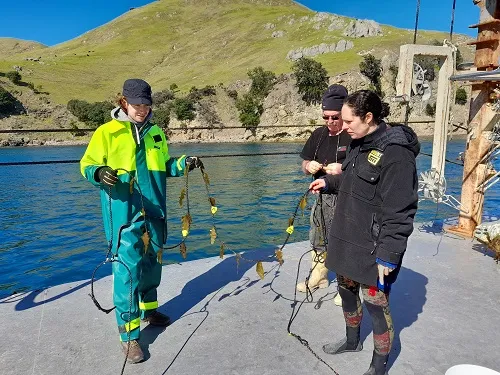
PhD student Jacob Nepper-Davidsen, Dave Blyth (Premium Seas Ltd) and Dr Rebecca Lawton with seaweed grow rope ready for outplanting (photo taken by Dr Marie Magnusson)
The pilot will include hatchery production, on water farming, seaweed processing, product trials and training programmes for seaweed farmers. It will provide the proof-of-concept for farming native seaweed at a commercial scale.
In partnership with iwi and local farmers, the pilot is focused on creating a viable community model from seed to sale. It aims to develop and support the establishment of seaweed farms throughout New Zealand, using a regenerative ocean farming model developed by GreenWave US in the United States.
The Government is contributing nearly $2 million through the Ministry for Primary Industries’ Sustainable Food and Fibre Futures fund to the three-year project, which is spearheaded by EnviroStrat. EnviroStrat and Healthy Waters, Auckland Council, are investing an additional $3 million. The University of Waikato will oversee the research and trial designs, with input from the University of Auckland’s marine science faculty.
Project partners Premium Seas Ltd and AgriSea Ltd will contribute their production, market, and processing expertise and local aquaculture farmers will provide onsite operations. Ngāi Tai ki Tāmaki is supporting the project by providing access to recently consented marine farming space and sharing knowledge of traditional Māori values to enhance the project's success. The project has also been supported by grants from Ākina, BayTrust, Foundation North, Ports of Auckland and The Tindall Foundation during its establishment phase.
A key part of the project is the development of aquaculture protocols for the native kelp Ecklonia radiata . "Although there is much knowledge to draw from internationally regarding kelp aquaculture, none of the major global commercial seaweed crops are native to New Zealand. This means that both hatchery and seeding protocols and farm designs need to be developed and tested for our local kelp species and conditions,” says Dr Magnusson.
The pilot will also quantify improvements in water quality from seaweed farming. “Seaweed are really effective at removing excess nutrients from the water, so in addition to producing biomass which can be turned into a range of valuable products, seaweed farming can also have significant positive impacts on marine ecosystems by improving water quality,” says Dr Lawton.
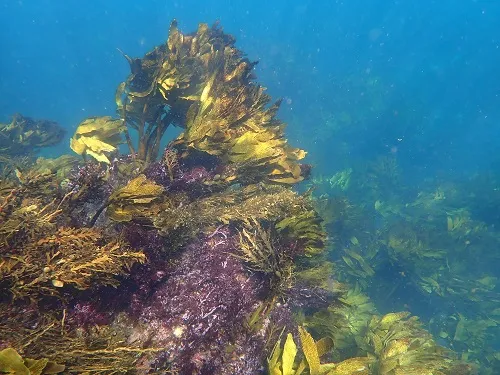
Seaweed is a huge multi-billion dollar industry in Asia, but the potential of seaweed is yet to be fully explored and maximised in New Zealand. Dr Magnusson says seaweed represents a largely untapped resource for materials and bioproducts that will enable sustainable diversification of New Zealand’s aquaculture industry.
The project will build on existing seaweed aquaculture research undertaken at the University of Waikato through the $13 million algal biotechnology research project , funded by the Tertiary Education Commission’s Entrepreneurial Universities programme and the University of Waikato.
- SDG 9 - Industry, Innovation and Infrastructure
- SDG 6 - Clean Water and Sanitation
- SDG 14 - Life Below Water
- School of Science

Related news
Gap year reflections to University of Waikato graduate
Top student among his Bachelor of Business cohort, Rawiri Tonga graduates from the University of Waikato.
Celebrating 60 years alongside Waikato University Alumni Olympians
The University of Waikato Alumni and Friends hosted some of its Olympic sporting alumni last week in celebration of the University’s 60th anniversary.
Mayor to Master’s: Moko Tepania makes waves in education
The Mayor of the Far North has graduated with his Master of Education with First Class Honours in in Māori Medium Education / Te Rōpū Tohu Paerua.
Waikato celebrates first nursing graduates
First cohort of registered nurses stepping out into the workforce.
You’re viewing this website as a domestic student
You’re currently viewing the website as a domestic student, you might want to change to international.
You're a domestic student if you are:
- A citizen of New Zealand or Australia
- A New Zealand permanent resident
You're an International student if you are:
- Intending to study on a student visa
- Not a citizen of New Zealand or Australia
Accessibility Quick Links

Seaweed research produces results
Joint media release 14 December 2020
Research on seaweed species found in abundance around New Zealand has led to the development and licencing of a promising new product.
The three-year research programme led by Scion set out to test the properties of different seaweeds, including Undaria pinnatifida and the commercially harvested, native species Ecklonia radiata . Two years into the project, researchers have already commercially licenced their first product – a nanocellulose hydrogel – to project partner AgriSea, a leader in the New Zealand Seaweed industry.
Hydrogels are used in burn wound dressings, biomedical engineering applications, drug delivery, cosmetics, and in agriculture supporting plant health to name a few examples. The gels can absorb vast amounts of water (up to 1000 times their own weight) to form a jelly-like substance.
Project partner AgriSea sees promise in the seaweed nanocellulose hydrogels and will continue developing them for their growing range of seaweed-based products. Both partners are hugely excited to see this project move to commercialisation so soon.
“Working with the team at Scion has been a fantastic journey. What started as a far-flung idea has quickly become a commercial reality. The new products are being created from what was essentially a low value waste stream for AgriSea. This sort of work ties in with our vision to create a high-value, long-term sustainable seaweed industry for New Zealand,” says Clare Bradley, Head of Research and Development at AgriSea.
Seaweed-based hydrogels offer not only a potential new revenue stream for New Zealand aquaculture but also access to new high-value onshore and export markets.
Scion programme leader Dr Stefan Hill says, “Seaweeds are unique. Their natural properties are quite different from plants that grow on land. We’re excited to see what else we can make from these seaweeds.”
Scion researchers were able to mechanically process the seaweed and extract the nanocellulose, which was then used to make the hydrogel.
Seaweed-based hydrogels have been made before, but never from species that are growing around New Zealand in sustainably harvestable quantities. The methods used to make the new nanocellulose hydrogels are also significantly cheaper than those currently in use.
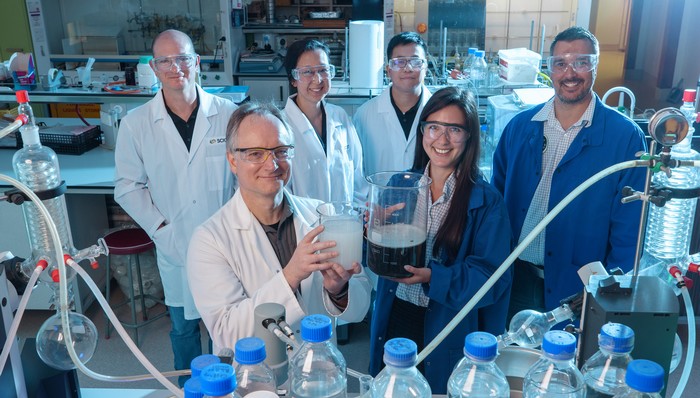
About AgriSea AgriSea manufactures seaweed products for the primary sectors including soil, plant, animal and bee nutrition. AgriSea products are widely used in the agriculture, viticulture, horticulture, and apiculture markets in NZ and to a growing export clientele. With a clear, long term R&D strategy in place, encompassing the whole supply chain, novel macro algae species and human nutrition, AgriSea is committed to providing innovative, proven and effective seaweed products that add value to people and planet. www.agrisea.co.nz
Aotearoa New Zealand has a vast marine estate that is increasingly under pressure, and the current legal framework for marine management is complex and fragmented.
Our research addresses the question: How can we best develop our marine economy, while protecting the taonga of our marine environment?
Where’s our research happening?
- Governance Group
- Challenge Leadership Team
- Kāhui Māori
- Stakeholder Panel
- Independent Science Panel
- VM Leadership Group
- Synthesis team
Vision Mātauranga
Mātauranga Māori informing and underpinning EBM for Aotearoa
Te Au o Te Moana story series
This series aims to whakamana (empower) the voices of researchers, co-developers, Māori partners and communities of research and practice as…
- Our research
- Tools & resources
News & events
News and updates about our research, outreach and engagement
Details of upcoming and past events, webinars, or public talks.
Our newsletter is sent out every 2–3 months
Media enquiries
Contact information for journalists
Seafood Magazine: Hot and cloudy waters ahead: forecasting the value of the pāua fishery
Shared with permission from Seafood New Zealand Magazine - March 2024 Flourishing fisheries rely on understanding environmental risks, uncertainties, and opportunities in a changing climate.
- Completed project
Building a seaweed sector
Developing a seaweed sector framework for Aotearoa New Zealand.
This project is complete and the Seaweed Sector Framework is now available. Other tools and resources are available at the bottom of this page.
S eaweed has huge potential to contribute to Aote a roa New Zealand’s blue economy .
In 2018, the global seaweed sector was valued at more than $13 billion USD , and grew 8% from 2016 to 2018 (fao.org). Global seaweed production has more than doubled in the last 20 years, exceeding natural supply - now more than 30% of global aquaculture production volume is seaweed.
Successful seaweed sectors overseas have hatcheries, large- and small-scale farming operations, processing capability and established seaweed-based products that supply market s. These are assisted by on-going research and development , and workforce support.
Here in Aotearoa N ew Zealand , we have a fledgling but highly dynamic seaweed sector operating at small scale s, but many gaps and barriers exist, limiting the potential growth .
With the right framework grounded in e cosystem - based management (EBM) principles, a thriving seaweed sector could be possible in Aotearoa New Zealand .
We are working with the iwi, stakeholders, industry, researchers, and government agencies that currently or plan to operate in the sector - either as farmers or as users of seaweed products - and consider the wider community , to co-develop a Seaweed Sector Framework grounded in blue economy and EBM principles. We:
- Part 1 focuses on markets and regulation, including future market opportunities and priorities. It also includes information drawn from industry interviews conducted by Transitioning to a blue economy project.
- Part 2 explores which species have characteristics of commercial interest, and Te Tiriti o Waitangi/Treaty of Waitangi considerations
- Part 3 explores the environmental effects of regenerative seaweed aquaculture (both positive and negative, ecosystem services and bioremediation)
- Are co-de veloping a s eaweed s ector f ramework for Aotearoa New Zealand , incorporating EBM principles .
- Are testing the framework using seaweed case studies to understand how it can effectively operate across different scales (e g local, regional, national and small to large businesses).
The Sustainable Seas Challenge defines a ‘blue economy ’ as:
Marine activities that generate economic value and contribute positively to ecological, cultural and social well-being .
Research Team
Serean Adams (Cawthron) Nigel Bradly (EnviroStrat) Rob Major (Cawthron) Marie Magnusson (UoW) Victoria Jollands (EnviroStrat) Sandra Cortez (EnviroStrat) Leo Zamora (Cawthron) Tom Wheeler (Cawthron) Emma Newcombe (Cawthron) Shaun Ogilvie (Cawthron) Te Rerekohu Tuterangiwhiu (Cawthron) Dana Clark (Cawthron) Paul South (Cawthron) Cam Inskeep (EnviroStrat) Donato Romanazzi (Cawthron) Rebecca Lawton (UoW) Chris Glasson (UoW) Deanna Clement (Cawthron) Cam Ingram (Cawthron) Andy Elliot (Auora, Wakatū)
Related News
- Seafood Magazine: Shaping the seaweed sector - 09 December 2022
- Aotearoa's seaweed sector is ready to boom - 07 October 2022
- Media coverage in June 2022 - 30 June 2022
- Media coverage in December 2021 - 31 December 2021
- Media coverage in November 2021 - 01 December 2021
- Seafood Magazine: Seaweed could be a game changer - 01 November 2021
- Six rimurimu/seaweed species could put Aotearoa New Zealand on the map - 01 November 2021
- Media coverage in October 2021 - 31 October 2021
- Media coverage in September 2021 - 30 September 2021
- Media coverage in August 2021 - 31 August 2021
- Developing a rimurimu/seaweed sector would hugely benefit Aotearoa New Zealand - 16 August 2021
- Marine indigenous knowledge crucial for solving global challenges - 09 June 2021
- 2,000+ school kids discovered why rimurimu/seaweed is the next wonder crop - 12 April 2021
- Media coverage in March 2021 - 31 March 2021
- NZ school kids learning why seaweed helps our economy and nature - 04 March 2021
- Blue economy: core research topics - 28 February 2020
- Media coverage in November 2019 - 30 November 2019
Related Events
Webinar: protect our future - perspectives from the un oceans conference, project proposal.
1016 KB | Adobe Acrobat PDF file
This is a national project.
August 2021
November 2021, august 2022, october 2022, tools & resources.
This project has produced or contributed to:
Carbon cycle within a seaweed farm
This infographic shows the pathways of carbon flow from seaweed aquaculture based on measurements and calculations of carbon sequestration p…
What will enable Aotearoa New Zealand's seaweed sector?
This infographic visualises the barriers and gaps that are impeding the sector, and what actions can be taken to address them. (August 2021)
Factsheet: Environmental considerations for seaweed aquaculture
Assessing the environmental effects of seaweed aquaculture in Aotearoa New Zealand (September 2023)
Possible ecosystem services and negative environmental effects associated with seaweed aquaculture in coastal environments
This infographic indicates the likely nature and degree of effect by large or small '-' or '+' symbols. (November 2021)
Key environmental considerations for seaweed aquaculture in Aotearoa New Zealand
Howarth L & Major R (October 2023)
Stocktake and characterisation of Aotearoa New Zealand’s seaweed sector: Market and regulatory focus
This report assesses current demand, supply and regulation, and opportunities for (and barriers to) growth of the rimurimu/seaweed sector in…
Stocktake and characterisation of Aotearoa New Zealand’s seaweed sector: Species characteristics and Te Tiriti o Waitangi considerations
This report provides an overview of seaweed species in Aotearoa that have commercial potential, as well as recognition of their cultural imp…
Stocktake and characterisation of Aotearoa New Zealand’s seaweed sector: Environmental effects of seaweed wild-harvest and aquaculture
This report describes the ecosystem services provided by seaweed and the potential environmental impacts of a seaweed sector. Clark DE, Newc…
Our research in action
These impact case studies show our research is supporting management, influencing policy, and inspiring the next generation. Each was develo…
Protect our future: perspectives from the UN Oceans conference
- Presentation
Webinar presentation by Sally Paterson (Live Ocean Foundation) and Nigel Bradly (EnviroStrat) August 2022 (20mins + q&a)
Aquaculture: Tools, resources and research
This is a research round-up of our tools, resources and research that are relevant to aquaculture. It is a living document, and more tools, …
Seafood: Tools, resources and research
This is a research round-up of our tools, resources and research that support an ecosystem-based management (EBM) approach to the seafood in…
Seaweed Sector Framework
This co-developed roadmap shows how Aotearoa New Zealand could grow its rimurimu/seaweed sector in a way for the country to gain environment…
Seaweed Summit
The first ever Seaweed Summit in Aotearoa New Zealand was held on 7 October 2022, organised in partnership with ANZSA, Aquaculture NZ and Ca…
A snapshot of the global seaweed sector
This infographic visualises: which seaweeds make up most of the global supply; what they are used for; growth of seaweed aquaculture in the …
Strategically launching a rimurimu/seaweed sector
This impact case study demonstrates the role Sustainable Seas research has played in understanding the current sector in Aotearoa New Zealan…
Te Au o Te Moana | Special webinar series: Blue Economy
Webinar presentation by Nick Lewis, Nigel Bradly, Julie Hall, Matt Miller, Simon Milne, John Reid & Oliver Wilson, April 2022 (60 mins + 27 …
Related projects & activities
Communicating risk and uncertainty.
- Active project
Creating guidelines, models and tools that explicitly identify risk and uncertainty, to help make decision-making more inclusive and multi-s…
Ecological responses to cumulative effects
This project brings together mātauranga Māori and science to develop new knowledge about cumulative effects
Enabling kaitiakitanga and EBM
Exploring how Kaitiakitanga and EBM can operate alongside one another within coastal and marine environments.
Spatially-explicit cumulative effects tools
We are incorporating cumulative effects of multiple stressors (from human activities on land and sea) into decision-making tools.
Transitioning to a blue economy
We have identified which marine activities have the potential to help New Zealand transition to a blue economy – ie they are sustainable, re…

- Pets travelling to NZ
- Bringing and posting items to NZ
- Clearance of personal goods and mail to NZ
- Arriving in NZ in your own boat or aircraft
- Pets leaving NZ
- Taking food overseas
- Sending food overseas from NZ
- Taking home your trophy or hide from NZ
- Boating and watersports tips to prevent spread of pests
- Recreational fishing
- Gardening: finding and reporting pests
- Holding an outdoor event: tips to prevent spread of pests
- Hunting and gathering: biosecurity and food safety
- Tramping tips to prevent spreading pests and diseases
- Visiting Waiuku Forest
- Learn more about biosecurity
- About New Zealand Food Safety
- Food recalls and complaints
- Food and pregnancy
- Safe food for babies
- Food allergies and intolerances
- Food for people with low immunity
- How to read food labels
- How Health Star Ratings work
- Food additives and preservatives
- Nutrients added to food
- Preparing and storing food safely at home
- Food safety tips for fishing, hunting, and homekill
- What is organic food?
- Is it safe to eat?
- Safe levels of chemicals in food
- Food poisoning: symptoms and causes
- Fundraising, community, and social event food safety
- Food safety tips when you're sick
- Food safety in natural disasters and emergencies
- Food safety resources
- Reducing food waste at home
- Food safety rules
- Starting a food business
- Running a food business
- Food safety toolkit
- Food recalls
- Labelling and composition of food and drinks
- Regulators and verifiers
- Food safety registers and lists
- Food safety legislation
- Importing food and beverages
- Exporting food and beverages
- Dairy products processing, manufacture, and testing requirements
- Bakery and grain-based products
- Honey and bee products processing requirements
- Meat and game processing requirements
- Seafood processing, storage, and testing
- Winemaking standards, requirements, and testing
- Poultry and egg processing requirements
- Transport, wharf, and cold and dry store operator food safety
- Maintenance and cleaning products in animal product processing
- Food safety and suitability research
- Food monitoring and surveillance
- Food safety codes and standards
- Food safety insights, emerging risks, and current issues bulletin
- Exporting from NZ: how it works
- Meeting NZ standards for export
- Export requirements
- Register as an exporter
- Exporting animal food
- Exporting wool, hides, trophies, and rendered animal products
- Exporting live animals
- Exporting grains and seeds for sowing
- Exporting live plants and laboratory plant products
- Exporting agricultural compounds
- Exporting timber and wood products
- Exporting veterinary medicines
- E-commerce: selling goods online to customers overseas
- Importing into NZ: how it works
- Border clearance: aircraft, boats, arrival, and clearance facilities
- Household goods and personal effects importing to NZ
- Importing food
- Importing timber and wood products
- Importing biological products and organisms
- Importing agricultural compounds and veterinary medicines (ACVM)
- Importing live animals
- Importing animal food
- Importing fibre, skins, and trophies
- Importing plants, flowers, seeds, and plant-growing products
- Importing inorganics and waste
- Importing vehicles, machinery, and parts
- Importing research samples (excluding animal samples)
- Importing soil, organic fertilisers and growing media of plant origin
- About biosecurity in New Zealand
- Pests and diseases not in New Zealand
- Find, report, and prevent pests and diseases
- Biosecurity at New Zealand's border
- Exotic pests and diseases in New Zealand
- Mycoplasma bovis disease eradication programme
- Biosecurity and your pets
- Animal welfare
- National Animal Identification and Tracing (NAIT) programme
- Foot-and-mouth disease response plans
- Veterinary medicines and the ACVM Act 1997
- Growth hormones
- Pet food, animal feed, and nutritional supplements
- Animal feed: preventing disease transfer
- Vertebrate toxic agents: making, selling, and using
- Slaughtering requirements
- Dropped hock syndrome
- Protecting pet rabbits from caliciviruses
- Agricultural compounds and veterinary medicines (ACVM)
- FarmsOnLine
- Plant products requirements and pesticide levels
- Dairy farming
- Poultry and eggs requirements
- Winemaking, standards, requirements, and testing
- Beekeeping: loss survey, tutin contamination, regulations
- Organic product requirements in NZ
- Farm management, the environment, and land use
- Adverse events
- Māori agribusiness funding and support
- Sustainable Food and Fibre Futures
- Primary Growth Partnership (PGP)
- Fishing and aquaculture funding and support
- Environment and natural resources: funding and programmes
- Funding programmes for tree planting and research
- Farming funds and programmes
- Future workforce skills for the primary industries
- Sustainable Regions funds and programmes
- Rural Community Hubs
- Mental wellbeing fund for rural communities
- Rural proofing: guidance for policymakers
- Wood Processing Growth Fund
- Jobs for Nature
- On Farm Support: a service for farmers and growers
- Commercial fishing
- Māori customary fishing
- Fisheries management
- Sustainable fisheries
- Aquaculture (fish and shellfish farming)
- Fisheries science and research
- Getting started in forestry
- New Zealand's forests
- National Environmental Standards for Commercial Forestry
- Funding for tree planting and research
- Native (indigenous) forests
- Forest industry and workforce
- Forestry in the Emissions Trading Scheme
- Protecting forests from summer wildfires
- Forest science and research
- Te Uru Rākau – New Zealand Forest Service
- For individuals Mā te takitahi
- Bring or send to NZ
- Take or send from NZ
- Outdoor activities
- Food safety at home
- For businesses Mā ngā pakihi
- Food business
- Biosecurity
- Agriculture
- Funding and rural support
- Fishing and aquaculture
- Media releases
Pilot project aims to establish commercial seaweed farming sector in New Zealand
MPI media team
029 894 0328
A $5 million commercial regenerative seaweed farming pilot backed by the government could mark the beginning of a new industry for New Zealand.
"Through our Sustainable Food and Fibre Futures fund (SFF Futures) we’re investing nearly $2 million in a pilot programme that aims to help seaweed farmers throughout New Zealand to establish their own farms, using a regenerative ocean farming model,” says Steve Penno, Ministry for Primary Industries' (MPI's) director of investment programmes.
"The model was developed by GreenWave in the United States, and the pilot will take place in the Hauraki Gulf and Bay of Plenty. It will include hatchery production, on-water farming, seaweed processing, and training programmes for seaweed farmers.”
Auckland Council is also investing $1.2 million in the 3-year project, with EnviroStrat and additional investors making up the balance. The project has been supported by grants from Ākina, BayTrust, Foundation North, Ports of Auckland and The Tindall Foundation during its establishment phase. Ngāi Tai ki Tāmaki is supporting the project by providing access to recently consented marine farming space and sharing knowledge of traditional Māori values to enhance the project's success.
The University of Waikato will lead the research and trial designs, and Premium Seas Limited and AgriSea will contribute their production, market and processing expertise.
"There’s limited research and development available for ocean-grown seaweed in Aotearoa currently, which is a significant barrier to establishing a seaweed sector," says Mawae Morton, Executive Chair of GreenWave NZ.
"This project will provide the proof-of-concept for farming New Zealand seaweed at a commercial scale. Positive findings will provide confidence to new entrants and co-investors, reducing the risk associated with the creation of a new sector.
"The intellectual property developed through the project will be accessible to the sector."
The project is developing hatchery facilities able to produce enough seaweed to support commercialisation. It will develop on-water farm infrastructure and growing techniques, and test production to prove the commercial viability of seaweed farming.
"Markets exist for locally produced seaweed-based products, and there is potential to develop future markets for blue carbon and nutrient credits," says Mr Penno.
"This project will measure the potential environmental benefits, which include increasing marine biodiversity, improving water quality through the uptake of nitrogen and phosphorous, carbon sequestration, and potential erosion protection for coastlines.
"Establishing commercial seaweed farming across the country will also provide new jobs in coastal communities where employment opportunities are more limited.
"This project complements our Fit for a Better World roadmap to increase exports, lower emissions, improve the environment and employ more people in the food and fibre sector.
"It will deliver economic growth and jobs for the regions, which will also contribute to the government’s goal of sustainably growing the value of the aquaculture industry 4-fold to $3 billion by 2035, and help to boost our economic recovery from the COVID-19 pandemic."
MPI business units

MPI uses cookies to improve your experience on our site. By using our website, you accept our use of cookies .

Supporting the growth of New Zealand’s rapidly evolving seaweed sector
About the client.
Established in 2014, the Sustainable Seas National Science Challenge is a 10-year, two phase government-funded research programme set up to address how we can best develop our marine economy, while protecting the taonga of our marine environment.
Executive Summary
EnviroStrat has been a significant contributor to the Sustainable Seas National Science Challenge blue economy workstream. In 2018/2019 we led a research project to identify marine activities that have the potential to create economic value whilst contributing positively to social, cultural and ecological wellbeing in New Zealand. This included a stocktake of national and international blue economy developments, and examined threats and opportunities for the New Zealand blue economy; one of which is the rapidly evolving seaweed sector.
While currently operating at small scale, with gaps and barriers limiting the sector’s ability to grow, seaweed has huge potential to be a game changer for New Zealand’s blue economy.
Our initial blue economy stocktake was the critical foundation for a subsequent research project, being led by Cawthron Institute, to develop a framework for a sustainable Seaweed Sector in New Zealand. The framework provides strategic prioritisation of key elements of a future sustainable seaweed sector. It includes consideration of species, product types, research needs, regulatory changes, the role of iwi and treaty considerations, and future business models that will enable sustainable growth of this promising sector.
The draft framework will be tested through case studies to understand how it can effectively operate, identifying and removing barriers and setting the scene for sustainable growth.
Our approach
Our blue economy stocktake identified a unique opportunity to develop the strategic context for a sustainable seaweed sector. Given the very early stage of the seaweed sector in New Zealand, we sought to do this across multiple lenses in a dynamic, multi-stakeholder context. This approach allows us to understand and prioritise opportunities and risks to ensure the rapidly emerging sector, regulatory changes, research needs, market demands, species, upstream/downstream infrastructure, supply chain and technology needs, environmental benefits and risks, and Māori aspirations.
About the seaweed sector
There is significant global and domestic interest in seaweed.
Between 2000 and 2018, the global farmed production increased more than tripled from almost 11 million tonnes to 32 million tonnes (worth USD 14 billion) ( FAO, 2020 )
Similar to the global experience, there is a great deal of domestic interest, including from the government, investors, the existing aquaculture sector, Māori, environmentalists and researchers.
A prosperous seaweed sector could provide meaningful economic, environmental, social and cultural benefits to local communities, along with broader impacts nationally. While numerous new initiatives and businesses are targeting seaweed as a novel primary resource for the blue economy, the New Zealand seaweed sector is still in its infancy and is not keeping pace with international developments.
The need for a seaweed sector framework
Our Blue Economy Stocktake identified that there is currently no overarching vision for a regenerative seaweed sector to guide regulatory frameworks, ecological sensitivities, climate change, relationship to protected areas, fairness/social justice, and systems implications of uncoordinated economic development. The development of a Seaweed Sector Framework is an important step to help support and guide the sector’s development.
Market sector review
The market sector review prepared by EnviroStrat was the first stage in the development of the Seaweed Sector Framework. It provided a characterisation of the New Zealand seaweed sector today, including current demand, supply and regulation, along with barriers to growth. Focus was on identifying opportunities and barriers to the sustainable growth of the sector. It helped us identify which species have characteristics of greatest commercial interest, future market opportunities, regulations and research priorities.
Inputs to this research report included reviews of sector reports and scientific papers, along with interviews of individuals involved in seaweed research, businesses, regulation and development projects.
For New Zealand to have a sustainable and high value seaweed sector, the market review report suggested:
- Establishing a seaweed sector group to foster collaboration and iwi / stakeholder engagement, share information and inform decision making, and set priorities and aspirations for development of the industry.
- Scoping, funding and developing high profit, high fit seaweed industries.
- Developing a clear pathway for’ ecosystem services’ markets from seaweed (e.g. blue carbon, nutrient extraction) in New Zealand.
- Prioritising research and development to support the sector, with initiatives that overcome collective hurdles and unlock the highest value opportunities for NZ to be prioritised. Consideration should be given to overseas research approaches that can be adapted, to maximise New Zealand’s research spend and avoid duplication.
- Developing a Government strategy, which informs regulatory solutions and funding priorities in line with the Framework. This should be a fit-for-purpose cross-agency regulatory framework including international harmonisation, marine spatial planning, consenting, permitting, and standards setting requirements.
- Develop a governance framework for the sector that incorporates Māori and mātauranga.
Cawthron Institute has led the development of two additional research reports that contribute to the overall Framework – Seaweed Sector Review (part 2): Species characteristics and Te Tiriti o Waitangi considerations and Seaweed Sector Review (part 3): Environmental effects of seaweed wild-harvest and aquaculture.

Testing the framework on real-life case studies
Our role has evolved from research to a more applied approach, with our responsibility now shifting to creating the draft framework. The framework draws from the research reports by EnviroStrat and Cawthron, as well as a series of interviews and focus groups with a range of iwi, stakeholders, researchers, and regulators. Using real-life case studies, we will assess how the seaweed framework can effectively operate across different scales, both regionally and operational size.
EnviroStrat has helped influence the direction of both public and private investment, and regulatory change in the sector. We have identified priorities for which species, product types and markets New Zealand should (and shouldn’t) be competing in, identified business models that align with a sustainable sector, and regulatory changes that will enable future sectoral growth.
The outcome will be a framework that will provide an easily accessible and understandable summary of a sector that will enable future participants to see where their perspectives fit.
Key Metrics
- Transitioning to a blue economy research report (2019)
- Development of the Seaweed Sector Framework (2020 – 2022)
- Multiple workshops with stakeholders, iwi, regulators and market participants considering different elements of framework resulting in strong support.
Previous Post From ‘assessment to investment’: the transition to a blue economy in India
Next post demystifying the blue economy in new zealand.
Comments are closed.

Quick Links
- Our Footprint
- Impact Investment
- Privacy Policy
Copyright EnviroStrat 2023 | Crafted by Mantis Digital
- Architecture and Design
- Asian and Pacific Studies
- Business and Economics
- Classical and Ancient Near Eastern Studies
- Computer Sciences
- Cultural Studies
- Engineering
- General Interest
- Geosciences
- Industrial Chemistry
- Islamic and Middle Eastern Studies
- Jewish Studies
- Library and Information Science, Book Studies
- Life Sciences
- Linguistics and Semiotics
- Literary Studies
- Materials Sciences
- Mathematics
- Social Sciences
- Sports and Recreation
- Theology and Religion
- Publish your article
- The role of authors
- Promoting your article
- Abstracting & indexing
- Publishing Ethics
- Why publish with De Gruyter
- How to publish with De Gruyter
- Our book series
- Our subject areas
- Your digital product at De Gruyter
- Contribute to our reference works
- Product information
- Tools & resources
- Product Information
- Promotional Materials
- Orders and Inquiries
- FAQ for Library Suppliers and Book Sellers
- Repository Policy
- Free access policy
- Open Access agreements
- Database portals
- For Authors
- Customer service
- People + Culture
- Journal Management
- How to join us
- Working at De Gruyter
- Mission & Vision
- De Gruyter Foundation
- De Gruyter Ebound
- Our Responsibility
- Partner publishers

Your purchase has been completed. Your documents are now available to view.
Seaweed utilisation in New Zealand
Loretta N. White is a doctoral candidate in the School of Science, Faculty of Health and Environmental Sciences at Auckland University of Technology. Loretta has a Master’s degree in Applied Science. Her research includes chemistry of algal bioactive compounds and their applications in food and cosmetics. She was the author of the first economic viability study funded by the Bioresource Processing Alliance and the Plant and Food Research Institute to investigate potential commercial use of invasive kelp Undaria pinnatifida in New Zealand, and a recognized expert in industrial fucoidan production from U. pinnatifida .
Professor William Lindsey White completed his PhD at the University of Auckland in 2001 and following a Post-Doctoral Fellowship took up a position as Senior Lecturer in the School of Applied Science at Auckland University of Technology (AUT). He is currently Associate Dean - Research and Enterprise and continues to carry out research in Phycology and Fisheries.
The commercial landscape of seaweed use in New Zealand (NZ) has shifted and evolved since it was last reviewed in 2006. One of the largest changes saw the introduction of Macrocystis pyrifera and green-lipped mussel spat (which is landed attached to beach-cast seaweed) into the Quota Management System—the primary tool for commercial fisheries management in NZ. There have also been policy changes around commercial harvesting and farming of Undaria pinnatifida , an introduced brown alga native to Asia. Traditionally, commercial algal utilization has been limited to agar production and beach-cast collection for aquaculture feeds, though demand for seaweed products has increased with a growing Asian population in NZ. The NZ seaweed industry is at an early developmental stage, but it has the potential to offer high quality seaweed stock and value-added products to the world market. The exploration of seaweed farming, the growing demand for seaweed fertilizers and the development of high-value bioactive products such as fucoidan has attracted interest from marine farmers and entrepreneurs. The key to success for the NZ seaweed industry rests in developing high-value products for an export market, from integrated farming, harvesting and processing that can deliver the most value, consume the least energy and generate minimal waste.
Article note: This article is part of the special issue series of Botanica Marina: Seaweed resources of the world: a 2020 vision, which has started publication in Botanica Marina 2019, vol. 62, issue 3. The series is guest-edited by Alan T. Critchley, Anicia Hurtado, Leonel Pereira, Melania Cornish, Danilo Largo and Nicholas Paul.
About the authors
Author contribution: All the authors have accepted responsibility for the entire content of this submitted manuscript and approved submission.
Research funding: None declared.
Conflict of interest statement: The authors declare no conflicts of interest regarding this article.
Abbott, I.A. (1996). Ethnobotany of seaweeds: clues to uses of seaweeds. Hydrobiologia 326/327: 15–20, https://doi.org/10.1007/bf00047782 . Search in Google Scholar
Alfaro, A.C. and effs, A.G. (2002). Small-scale mussel settlement patterns within morphologically distinct substrata at Ninety Mile Beach, northern New Zealand. Malacologia 44: 1–15. Search in Google Scholar
Alfaro, A.C., cArdle, B., and effs, A.G. (2010). Temporal patterns of arrival of beachcast green-lipped mussel (Perna canaliculus) spat harvested for aquaculture in New Zealand and its relationship with hydrodynamic and meteorological conditions. Aquaculture 302: 208–218, https://doi.org/10.1016/j.aquaculture.2010.02.028 . Search in Google Scholar
Alfaro, A.C., Jeffs, A.G., ardner, J.P.A., Bollard Breen, B.A., and Wilkin, J. (2011). Green-lipped mussels in GLM 9, Available at: https://docs.niwa.co.nz/library/public/FAR2011-48.pdf (Accessed 2 November 2019). Search in Google Scholar
Andrew, N.L. and Choat, J.H. (1985). Habitat related differences in the survivorship and growth of juvenile sea urchins. Mar. Ecol. Prog. Ser. 271: 155–161, https://doi.org/10.3354/meps027155 . Search in Google Scholar
Angeloni, A. (2018). Underwater seaweed forests tipped as next big thing in climate change fight. Stuff, Available at: https://www.stuff.co.nz/business/108803612/underwater-seaweed-forests-tipped-as-next-big-thing-in-climate-change-fight (Accessed 3 November 2019). Search in Google Scholar
Anonymous. (2010a). Seaweed research projects, Available at: http://www.option4.co.nz/Fish_Forums/documents/Hui_April10_Seaweed_research.pdf (Accessed 1 December 2019). Search in Google Scholar
Anonymous. (2010b). Sustainable seaweed management, Available at: http://www.option4.co.nz/Fish_Forums/documents/Hui_April10_Seaweed_management.pdf (Accessed 1 December 2019). Search in Google Scholar
Brown, M.T. and Zemke-White, W.L. (2006). New Zealand’s seaweed resources. In: Critchley, A.T., Ohno, M., and Largo, D. (Eds.), Seaweed resources. Expert Centre for Taxonomic Identification (ETI), Univ. Amsterdam (CD-ROM series) . Search in Google Scholar
Brown, M.T., Nyman, M.A., Keogh, J.A., and Chin, N.K.M. (1997). Seasonal growth of the giant kelp Macrocystis pyrifera in New Zealand. Mar. Biol. 129: 417–424, https://doi.org/10.1007/s002270050182 . Search in Google Scholar
Cambie, R.C. and Ferguson, L.R. (2003). Potential functional foods in the traditional Maori diet. Mutat. Res.-Fund. Mol. M. 523–524: 109–117, https://doi.org/10.1016/s0027-5107(02)00344-5 . Search in Google Scholar
Campbell Live . (2012). Campbell Live in Akaroa - 23rd February 2012. In Campbell Live: New Zealand TV3 . (Episode of TV programme). Search in Google Scholar
Choat, J.H. and Ayling, A.M. (1987). The relationship between habitat structure and fish faunas on New Zealand reefs. J. Exp. Mar. Biol. Ecol. 100: 257–284, https://doi.org/10.1016/0022-0981(87)90005-0 . Search in Google Scholar
Dawczynski, C., Schubert, R., and Jahreis, G. (2007). Amino acids, fatty acids, and dietary fibre in edible seaweed products. Food Chem . 103: 891–899, https://doi.org/10.1016/j.foodchem.2006.09.041 . Search in Google Scholar
de Winton, M.D., Hawes, I., Clayton, J.S., Champion, P.D., and Smith, R.K. (1998). Sea lettuce dynamics and ecophysiology in Tauranga Harbour, Bay of Plenty. Prepared for Environment B.O.P. , Tauranga District Council and Western Bay of Plenty District Council. Search in Google Scholar
Dean, F., Miller, S., Holmes, A. (2013). An investigation into the potential use of sea lettuce (Ulva lactuca) as a soil amendment in vegetable gardens and orchards . Bay of Plenty Regional Council, pp. 1–29. Search in Google Scholar
Edge, K. (2019). Spat over harvesting of mussel seeds from Ninety Mile Beach. NZ Herald. Search in Google Scholar
Falshaw, R., Bixler, H.J., and Johndro, K. (2003). Structure and performance of commercial kappa-2 carrageenan extracts. Part III. Structure analysis and performance in two dairy applications of extracts from the New Zealand red seaweed, Gigartina atropurpurea. Food Hydrocoll . 17: 129–139, https://doi.org/10.1016/s0268-005x(02)00045-0 . Search in Google Scholar
Fisheries New Zealand . (2019). Fisheries Assessment Plenary, May 2019: stock assessments and stock status . Wellington, New Zealand: Fisheries New Zealand, Available at: https://fs.fish.govt.nz/Doc/24726/May-Plenary-2019-Vol1.pdf.ashx (Accessed 2 December 2019). Search in Google Scholar
Gibbons, C. (2014). Huge potential for the seaweed industry. Seafood New Zealand , 22: 1–1. Search in Google Scholar
Gutierrez, A., Correa, T., Muñoz, V., Santibáñez, A., Cáceres, C., and Buschmann, A.H. (2006). Farming of the giant kelp Macrocystis pyrifera in southern Chile for development of novel food products. J. Appl. Phycol. 18: 259–267, https://doi.org/10.1007/s10811-006-9025-y . Search in Google Scholar
Hawes, I. (2001). Sea lettuce and Gracilaria in the Avon-Heathcote estuary. NIWA client report CHC01/90. Prepared for Christchurch City Council. Christchurch, NIWA. p. 18. Search in Google Scholar
Hawes, I. and Smith, R.A. (1995). Effect of current velocity on the detachment of thalli of Ulva lactuca (Chlorophyta) in a New Zealand estuary. J. Phycol. 31: 875–880, https://doi.org/10.1111/j.0022-3646.1995.00875.x . Search in Google Scholar
Hawes, I., Hall, J., and Pridmore, R.D. (1992). Research directed towards the management of sea lettuce in Bay of Plenty Coastal waters. Unpublished Contract Report prepared for Environment Bay of Plenty. Search in Google Scholar
Hay, C.H. (1994). Durvillaea (Bory). In: Critchley, A. T. and Ohono, M. (Eds.), Seaweed resources of the world . International Co-operation Agency, Yokosuka, Japan, pp. 127–137. Search in Google Scholar
Hay, C.H. and Luckens, P.A. (1987). The Asian kelp Undaria pinnatifida (Phaeophyta: Laminariales) found in a New Zealand harbour. New Zeal. J. Bot. 25: 329–332, https://doi.org/10.1080/0028825x.1987.10410079 . Search in Google Scholar
Hay, C.H. and Villuota, E. (1993). Seasonality of the adventure Asian Kelp Undaria pinnatifida in New Zealand. Bot. Mar. 36: 461–476, https://doi.org/10.1515/botm.1993.36.5.461 . Search in Google Scholar
Heesch, S., Broom, J., Neill, K., Farr, T., Dalen, J., and Nelson, W. (2007). Genetic diversity and possible origins of New Zealand populations of Ulva (2007/01). Biosecurity New Zealand Technical Paper No: 2007/01. Search in Google Scholar
Hepburn, C.D., Holborow, J.D., Wing, S.R., Frew, R.D., and Hurd, C.L. (2007). Exposure to waves enhances the growth rate and nitrogen status of the giant kelp Macrocystis pyrifera. Mar. Ecol. Prog. Ser. 339: 99–108, https://doi.org/10.3354/meps339099 . Search in Google Scholar
Hurd, C.L., Nelson, W.A., Falshaw, R., and Neill, K.F. (2004). History, current status and future of marine macroalgal research in New Zealand: taxonomy, ecology, physiology and human uses. Phycol. Res. 52: 80–106, https://doi.org/10.1111/j.1440-1835.2004.tb00318.x . Search in Google Scholar
James, K., Kibele, J., and Shears, N.T. (2015). Using satellite-derived sea surface temperature to predict the potential global range and phenology of the invasive kelp Undaria pinnatifida. Biol. Invasions 17: 3393–3408, https://doi.org/10.1007/s10530-015-0965-5 . Search in Google Scholar
Jeffs, A.G., Delorme, N.J., Stanley, J., Zamora, L.N., and Sim-Smith, C. (2018). Composition of beachcast material containing green-lipped mussel (Perna canaliculus) seed harvested for aquaculture in New Zealand. Aquaculture 488: 30–38, https://doi.org/10.1016/j.aquaculture.2018.01.024 . Search in Google Scholar
Jones, G.P. (1984). Influence of habitat and behavioral interactions on the local distribution of the wrasse, Pseudolabrus celidotus. Envir. Biol. Fishes. 10: 43–58, https://doi.org/10.1007/bf00001661 . Search in Google Scholar
Kain, J.M. (1982). Morphology and growth of the giant kelp Macrocystis pyrifera in New Zealand and California. Mar. Biol. 67: 143–157, https://doi.org/10.1007/bf00401280 . Search in Google Scholar
Kidgell, J.T., Magnusson, M., de Nys, R., and Glasson, C.R.K. (2019). Ulvan: a systematic review of extraction, composition and function. Alg. Res. 39: 101422, https://doi.org/10.1016/j.algal.2019.101422 . Search in Google Scholar
Lawton, R.J., Mata, L., de Nys, R., and Paul, N.A. (2013). Algal bioremediation of waste waters from land-based aquaculture using Ulva: selecting target species and strains. PloS One 8: e77344, https://doi.org/10.1371/journal.pone.0077344 . Search in Google Scholar PubMed PubMed Central
Lotze, H., Milewski, I., Fast, J., Kay, L., and Worm, B. (2019). Ecosystem-based management of seaweed harvesting. Bot. Mar. 62: 395–409, https://doi.org/10.1515/bot-2019-0027 . Search in Google Scholar
MAF . (2009). Review of the Undaria commercial harvest policy, Available at: https://www.biosecurity.govt.nz/dmsdocument/19880/direct (Accessed 1 December 2019). Search in Google Scholar
MAF . (2010). The commercial use of Undaria pinnatifida – An exotic Asian Seaweed, Available at: https://www.biosecurity.govt.nz/dmsdocument/19889/direct (Accessed 1 December 2019). Search in Google Scholar
MAF . (2011). Selected heavily infested areas for farming Undaria – October 2011, Available at: https://www.biosecurity.govt.nz/dmsdocument/19886/direct (Accessed 1 December 2019). Search in Google Scholar
McKee, J.W.A., Kavalieries, L., Brasch, D.J., Brown, M.T., and Melton, L.D. (1992). Alginate content and composition of Macrocystis pyrifera from New Zealand. J. Appl. Phycol. 4: 357–369, https://doi.org/10.1007/bf02185794 . Search in Google Scholar
Metzner, R., Harte, M., and Leadbitter, D. (2003). Experiences with Fisheries Co-management in Australia and New Zealand. In: Wilson, D.C., Nielsen, J.R., and Degnbol, P. (Eds.), The Fisheries Co-management Experience . Springer, Netherlands. pp. 171–189. 10.1007/978-94-017-3323-6_11 Search in Google Scholar
Miller, I.J. (1999). Towards a seaweed industry. In: Hogan, D. and Williamson, B. (Eds.), New Zealand is different–chemical milestones in New Zealand history . Clerestory Press, Christchurch, New Zealand. pp. 189–197. Search in Google Scholar
Ministry for Primary Industries . (2013). Rules on marine farming Undaria in New Zealand. https://www.biosecurity.govt.nz/biosecuritynz : biosecurity New Zealand, Available at: https://www.mpi.govt.nz/dmsdocument/3585-rules-on-marine-farming-undaria-in-new-zealand (Accessed 1 December 2019). Search in Google Scholar
Ministry of Fisheries NZ. (2007). Fisheries plan: New Zealand seaweed fisheries, Available at: https://fs.fish.govt.nz/Doc/16407/Stage%201%20Draft_The%20Current%20Situation_Introduction_24SEP07.pdf.ashx (Accessed 12 November 2019). Search in Google Scholar
Ministry of Fisheries NZ. (2009a). Beach cast seaweed harvesting areas - final advice paper, Available at: http://www.option4.co.nz/Fisheries_Mgmt/documents/FAPBeachCastSeaweed11009.pdf (Accessed 12 November 2019). Search in Google Scholar
Ministry of Fisheries NZ. (2009b). Minister of Fisheries notice of decisions: October 2009 sustainability measures and other management controls. (Report No. H0454), Available at: http://www.option4.co.nz/Fisheries_Mgmt/documents/Minr_decision_sustainability_1_10_09.pdf (Accessed 2 December 2019). Search in Google Scholar
Neill, K., Nelson, W., Kelly, M., and Herr, B. (2016). Beautiful browns - a guide to the large brown seaweeds of New Zealand. Available at: https://www.niwa.co.nz/static/web/MarineIdentificationGuidesandFactSheets/Beautiful_Browns_Ver1-2016-NIWA.pdf (Accessed 2 December 2019). Search in Google Scholar
Nelson, W.A., Neill, K.F., and D’Archino, R. (2015). When seaweeds go bad: an overview of outbreaks of nuisance quantities of marine macroalgae in New Zealand. New Zeal. J. Mar. Fresh. 49: 472–491, https://doi.org/10.1080/00288330.2015.1064975 . Search in Google Scholar
Nelson, W.A., Neill, K.F., D’Archino, R., and Rolfe, J.R. (2019). Conservation status of New Zealand macroalgae, 2019. In: New Zealand Threat Classification Series 30 . Department of Conservation, Wellington. p. 33. Search in Google Scholar
New Zealand Gazette Office. (2017). Notice Specifying Fish Species Which May Be Farmed (Notice No. MPI 842). (2018-go370). New Zealand Gazette Office. Search in Google Scholar
North, W.J. (1986). Biology of the Macrocystis resource in North America. In: Fisheries Technology Papers, Food and Agriculture Organization (FAO), United Nations , vol. 281: pp. 265–312. Search in Google Scholar
Parsons, M.J. (1994). Status of the introduced brown seaweed Undaria in New Zealand. Conservation Advisory Science Notes No . 112,: 1–24. Search in Google Scholar
Priestly, R. (2013). Secret ingredient: Sea lettuce. Stuff, Available at: http://www.stuff.co.nz/life-style/food-wine/8450458/Secret-ingredient-Sea-lettuce (Accessed 2 December 2019). Search in Google Scholar
Rapson, A.M., Moore, L.B., and Elliot, I.L. (1942). Seaweed as a source of potash in New Zealand. N.Z. J. Sci. Technol. 23: 150B–170B. Search in Google Scholar
Schaffelke, B., Smith, J.E., and Hewitt, C.L. (2006). Introduced Macroalgae – a Growing Concern. J. Appl. Phycol. 18: 529–541, https://doi.org/10.1007/s10811-006-9074-2 . Search in Google Scholar
Schiel, D.R. and Foster, M.S. (2006). The population biology of large brown seaweeds: ecological consequences of multiphase life histories in dynamic coastal environments. Annu. Rev. Ecol. Evol. Syst. 37: 343–372, https://doi.org/10.1146/annurev.ecolsys.37.091305.110251 . Search in Google Scholar
Schiel, D.R. and Nelson, W.A. (1990). The harvesting of macroalgae in New Zealand. Hydrobiologia 204: 25–33, https://doi.org/10.1007/bf00040211 . Search in Google Scholar
Seafood New Zealand . (2006). Brown, red and green gold? The great seaweed debate. Seafood New Zealand 14: 26–29. Search in Google Scholar
Sondak, C.F.A., Ang, P.O., Beardall, J., Bellgrove, A., Boo, S.M., Gerung, G.S., Hepburn, C.D., Hong, D.D., Hu, Z., Kawai, H., et al. (2017). Carbon dioxide mitigation potential of seaweed aquaculture beds (SABs). J. Appl. Phycol. 29: 2363–2373, https://doi.org/10.1007/s10811-016-1022-1 . Search in Google Scholar
Tantau, K. (2019). Turning ‘sea gorse’ into gourmet export product. Stuff , Available at: https://www.stuff.co.nz/business/115458963/turning-sea-gorse-into-gourmet-export-product (Accessed 2 December 2019). Search in Google Scholar
Taunton, E. (2018). ‘Gorse of the sea’ turned into plant products. Stuff , Available at: https://www.stuff.co.nz/business/farming/106969500/gorse-of-the-sea-turned-into-plant-products (Accessed 3 November 2019). Search in Google Scholar
Uwai, S., Nelson, W., Neill, K., Wang, W.D., Aguilar-Rosas, L.E., Boo, S.M., Kitayama, T., and Kawai, H. (2006). Genetic diversity in Undaria pinnatifida (Laminariales, Phaeophyceae) deduced from mitochondria genes – origins and succession of introduced populations. Phycologia 45: 687–695, https://doi.org/10.2216/05-66.1 . Search in Google Scholar
White, W.L. and Wilson, P. (2015). World seaweed utilization. In: Tiwari, B.K. and Troy, D.J. (Eds.), Seaweed sustainability: food and non-food applications . Academic Press, San Diego, pp. 7–25. 10.1016/B978-0-12-418697-2.00002-7 Search in Google Scholar
White, L., Lu, J., and White, W.L. (2014). Scoping assessment of the economic viability of harvesting Undaria pinnatifida from NZ mussel lines and potential uses of the collected material. Applied Ecology New Zealand Report 14/01. Auckland University of Technology, Auckland. p. 76. Search in Google Scholar
Zemke-White, W.L., Bremner, G., and Hurd, C.L. (1999). The status of commercial algal utilization in New Zealand. Hydrobiologia 398-399: 487–494, https://doi.org/10.1007/978-94-011-4449-0_59 . Search in Google Scholar
Zemke-White, W.L., Speed, S.R., and McClary, D.J. (2005). Beach-cast seaweed: a review. In: New Zealand fisheries assessment report 2005/144 , vol. 2005. Ministry of Fisheries, Wellington. Search in Google Scholar
© 2020 Walter de Gruyter GmbH, Berlin/Boston
- X / Twitter
Supplementary Materials
Please login or register with De Gruyter to order this product.
Journal and Issue
Articles in the same issue.
Cawthron Institute’s National Algae Research Centre to advance seaweed research
30 November 2020
Cawthron Institute is set to advance its world-leading algae research with construction of its National Algae Research Centre now underway.
Thanks to $6m of funding from the Government’s Provincial Growth Fund, the Centre will enable Cawthron to expand its internationally recognised work in the rapidly growing algae sector and create value for existing and new partners.
Based at Cawthron’s Aquaculture Park at the Glen, the National Algae Research Centre at this site will predominantly focus on macroalgae (seaweed).
“Seaweed cultivation is the world’s fastest growing aquaculture sector, with the global seaweed industry worth more than US$6bn per year. There are many species that have the potential to be transformed into a range of commercial products as well offering environmental benefits to counteract climate change,” said Cawthron Chief Executive Prof. Charles Eason.
“We see the Centre as a bridge from science to industry, connecting R&D to commercial application. This facility will allow our scientists to further explore the economic and environmental value of different seaweed species.”
“We believe our seaweed research, alongside our other aquaculture research, could significantly contribute to achieving the government’s target of aquaculture becoming a $3bn industry by 2035. Last year alone New Zealand’s aquaculture sector generated over $600m in revenue, employing over 3000 kiwis, and we believe our science will help to grow the sector further.”
Global and national interest in seaweed is high with much of the focus on red seaweeds. The farming of brown and green seaweeds has already been established internationally, so there is strong commercial interest in New Zealand red seaweed species Asparagopsis armata and Karengo.
For the past year Cawthon has been looking at how to grow Asparagopsis, which has been proven in overseas trials to reduce greenhouse gas emissions in livestock by up to 90 percent when used as supplementary feed.
“Our aim is to help industry develop economic seaweed farming systems for the future, so our research has been looking at how to generate a sustainable supply of juvenile Asparagopsis for seeding out on farms,” said Cawthron Algae and Bioactives Science Lead Dr Johan Svenson.
“Asparagopis is native in New Zealand, but there is not enough of it to meet the potential demand from farmers which could be thousands of tonnes each year. Red seaweeds are generally more complex to grow and especially at scale, so having this facility to carry out more lab-scale experiments will help expedite this type of research.”
Cawthron is also investigating the nutritional properties of Karengo, a seaweed long known to Maori as a traditional source of food. Through the High-Value Nutritional Science Challenge, the aim of the research is to determine Karengo’s potential as a high-value food for aquaculture.
A separate facility will be constructed in 2021 to continue Cawthron’s specialist work in extracting high-value bioactive compounds from microalgae, which will also form part of the National Algae Research Centre.
“We already work with a range of commercial partners to optimise the growth of healthy algae strains for successful aquaculture and increasingly to identify algal species, like Asparagopsis, with the potential to produce high-value products, said Prof. Eason.
Mark Rawson, Chief Executive of the Nelson Regional Development Agency, says the National Algae Research Centre will support Nelson Tasman’s successful ocean economy. “Cawthron Institute is well known as one of our region’s clever businesses, delivering science that has real-world impact particularly in our aquaculture sector. This Centre will play an important role in supporting our aquaculture, food, and nutraceutical industries to develop innovative new products and will assist in attracting high-calibre talent to the region”.
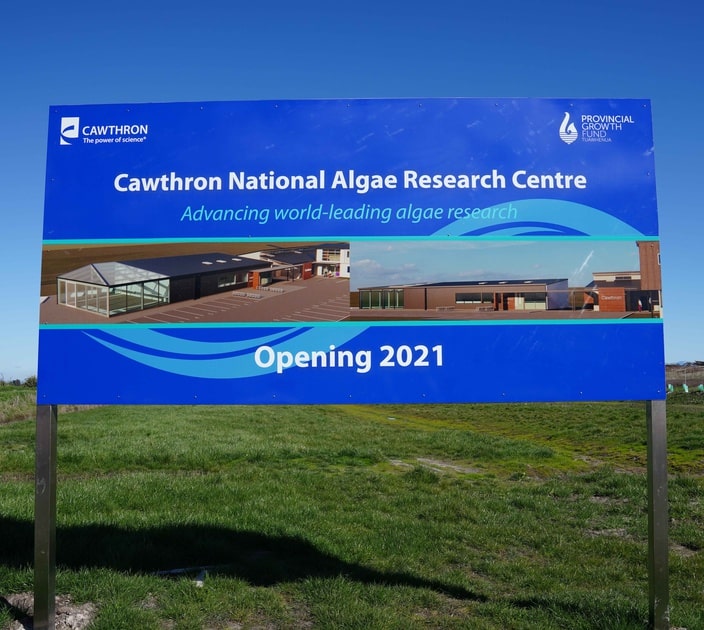
Meet the team
Can Seaweed Save the Planet? Meet the Indigenous-Led New Zealand Biotech Company Aiming to Do Just That
By Findlay Buchanan
Last updated: Feb 15, 2023
Table of contents
25 years of seaweed
Agrisea’s future projects.
Through partnerships with local indigenous groups, family-owned biotech enterprise AgriSea aims to boost sustainable farming – in New Zealand and abroad.
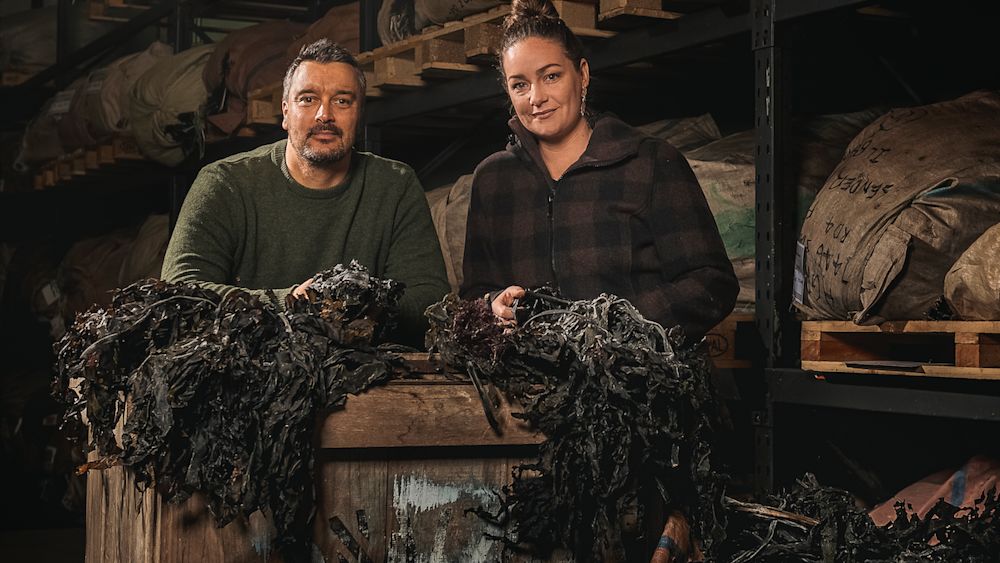
With 10% annual growth , New Zealand’s tech sector is growing faster than any other domestic industry — and many startups are stepping onto the global stage. It’s not just white guys in muted offices, either. Many indigenous-led tech companies are solving global problems and shaping the future of New Zealand’s economy.
Among the most promising is Auckland-based biotech company AgriSea , which recently won New Zealand’s most coveted tech accolade, the NZ Hi-Tech Award as Māori (the term for New Zealand indigenous) company of the year.
AgriSea harvests seaweed – a plentiful natural resource lining New Zealand’s expansive coastlines – then cleverly formulates “biostimulants” to help local and international farmers practice sustainable farming.
Globally, the biostimulants market was valued at $2.85 billion (USD) in 2021 and is projected to grow from $3.14 billion in 2022 to $6.69 billion by 2029. Since its founding in 1998, AgriSea has managed to capture a major slice of this burgeoning market: it employs over 50 staff, continuing to grow offshore, reportedly doubling its export orders compared with the same quarter of the previous year. Although AgriSea is a family-run business with no current outside investors, Bradley said, the company plans to open up to investment as the industry matures.
The applications of these biostimulants extend from soil, pasture and animal health, to cleaning waterways, as well as wound care and cosmetics for humans. The company has even won an award for proto-typing a formulation that reduces the stress of cows and can help stave off diseases in animals and insects, including honey-producing bees.
“AgriSea has always been first and foremost about health and wellbeing, providing nutritional products that support our primary industries both here in New Zealand and overseas,” Chief Innovation Officer Tane Bradley told The Org.
As AgriSea celebrates its win at the NZ Hi-Tech awards, it has simultaneously marked a quarter of a century, evolving from a local startup into a global enterprise. Today, it exports to offshore markets, and it even partnered with Los Angeles-based beekeeping company Pierco .
“It’s been a journey, that’s for sure. We now have friends”, laughed Bradley, referring to its many connections across the seaweed sector, governance, research agencies and environmentalists.
The company is an intergenerational family-run business, pioneered by Bradley’s wife, Clare (CEO of AgriSea), mother Jill Bradley and stepfather Keith Atwood, who laid the foundation of seaweed to improve the health of land and animals.
Though the company has a rich heritage, it remains laser-focused on the future. AgriSea recently secured a $1.5 million innovation fund grant from the New Zealand government to build the world’s first commercial seaweed-based nano cellulose manufacturing plant, enabling AgriSea to scale up, diversify and produce commercial volumes of nanocellulose hydrogel using leftovers from the manufacture of its agricultural and horticultural products.
Of the company’s journey, Bradley said: “We have always had a strong focus on R&D but once Clare and I took over, we set out to strengthen and widen this. We now work with some of New Zealand’s leading research agencies to better understand the value that seaweed can bring.”
AgriSea also has a research collaboration with New Zealand’s National Science Challenge funding allocated to the Revitalise te Taiao land-use sustainability program, which has seen a local Paeroa-based project, led by AgriSea, allocated $2.7 million to test farming methods that aim to enhance the health and strength of the soil across 10 farms.
AgriSea’s Paeroa-based Rere ki Uta, Rere ki Tai project - which roughly translates to “bringing together indigenous knowledge and regenerative agriculture” - secured $2.7 million from the National Science Challenge to fund research into whether farming methods can enhance soil to be more resilient, more profitable and healthier for all.
The collection and regeneration of seaweed – an essential resource for the birds and insects that live along New Zealand’s coastlines – is also a key function of the business. Bradley pointed to its close relationship with the Seaweed Association of New Zealand (SANZ) - of which his mother Jill was a founding member.
“In recent times, there have been some great advancements in the aquaculture opportunities around farming seaweed,” Bradley explained. These opportunities pull together "industry and interested parties to … work together and take care of our resources, while also providing business opportunities and job creation.”
Bradley said AgriSea’s continued partnership across iwi (tribes), hapū (subtribes) and remote coastal whanau (family) will “help us grow the seaweed aquaculture sector in Aotearoa in a way that is in line with community impact.”
The company already has 25 years of growth and success under its belt. So, what is the long-term vision for AgriSea?
“We see ourselves as a small but mighty company, always trying to punch above our weight when it comes to impact,” said Bradley. “We are setting on solving some big issues for our future generation such as climate change, plastic pollution, and soil and water degradation with the use of indigenous and science knowledge intertwined.”
Get in front of millions of visitors and job seekers.
- Showcase your company culture to a vast community of professionals
- Host your team on a free org chart to keep employees aligned
- Post jobs on our free job platform for high growth startups
Learn more →
In this article

The ORG helps you hire great candidates
Free to use – try today
2023's Leading Remote Companies
13 min read
The 10 Coolest Companies Hiring in LA Right Now
Employer branding news roundup - april 6, 2023, companies founded by women that are breaking barriers.

Nature-based solutions: Seaweed
Kelp image: Shane Stagner
Native Ecosystems
- Native ecosystems: our climate superheroes
- Our natural heritage
- The villains: predators & pests
- Our native forests
- Our soils: carbon super-sponges
- Our rivers & lakes
- Our wetlands
- Our dunes & coastal wetlands
- Our estuaries & hapua
- Our oceans: the ultimate climate superheroes
- Our blue carbon
- Ecosystem services: free stuff from Nature
- Losing our biodiversity
- Plants & animals on the move!
Other sections
- Our places: what we’re doing!
- Climate wiki
Home > Nature-based solutions > New Zealand native ecosystems > Ocean ecosystems > Seaweed
Blue carbon: Seaweed
- Seaweed includes kelp (macroalgae), which are the largest, and other marine plants such as seagrasses. Fed by the sun, some species of kelp can grow up to 1m/day, drawing down as much as five times more carbon dioxide from the atmosphere than rainforests, and permanently sequestering it:
“All you need to do is cut that seaweed off, and it drifts into the ocean abyss. Once it’s down a kilometre the carbon in that seaweed is effectively out of the atmospheric system for centuries or millennia. But if you plant the forest you’ve got to worry about forest fires, bugs, etc. releasing that that carbon.” – Prof. Tim Flannery ( Video 1 ).
- This is only true when seaweed is when considered by itself. When considered as part of an ecosystem, it may contribute to carbon dioxide emissions . See trophic systems at the bottom of this page .
- When cows eat the seaweed Asparagopsis it reduces their methane emissions (around 50% of NZ’s emissions are from agriculture ; 80% of methane is from ruminant animals, mostly dairy cows).
- Seaweed reduces the acidity of seawater immediately around it. This could help resolve problems faced by mussels and oyster farms as the ocean become more acidic .
- The Seaweed Sector Framework shows how Aotearoa could grow its rimurimu/seaweed sector (October 2022 – see Seaweed Summit)
“Kelp forests provide services worth between $465 billion and $562 billion a year worldwide, mainly by providing a habitat for valuable fish and seafood species, and by removing nitrogen from contaminated seawater. The results suggest that each type of kelp forest (see ‘Seaweed services’) generates up to $147,100 per hectare annually.” – Nature article April 2023
- BlueCarbonNZ are undertaking a research programme with NIWA to quantify the accumulation of kelp-derived carbon in deep-sea environments, while KelpBlueNZ is working on a pilot farm in Akaroa.
- Over-fishing of snapper and lobster has already led to a population explosion of kina sea-urchins, which are devastating kelp forests. Increasing marine heatwaves are also placing kelp forests and seagrasses at risk.

Faster and longer carbon sequestration…
Seaweed is a diverse group of marine macro-algae and plants that, like all plants, uses photosynthesis and carbon dioxide to grow. While it’s well understood that kelp stores far more carbon than trees, and it does so faster, the exact amount hasn’t been quantified. In New Zealand, one of Blue Carbon Services Ltd research projects in conjunction with NIWA is to quantify how much carbon is in natural kelp beds that grow along the coast, and ends up accumulating in deep-sea (continental shelf, slope, and submarine canyons) sediments. Knowing this would go a long way to creating a genuinely safe and reliable carbon market, one that does not require sacrificing land-based ecosystems for profit, and one that may also enhance seafood production through multi-trophic aquaculture.
“ New Zealand is well suited to this Greenfield form of carbon seques tration due to the presence of submarine canyons leading to very deep water around its continental shelf. Blue Carbon contrasts sharply fro m carbon sequestration by traditional terrestrial forestry. Terrestrial forestry is only able to store carbon in a living form and, therefore, reaches maximum storage capacity very quickly. Furthermore, commercial plantation fores try systems become net carbon emitters after 90 to 140 years due to the emissions p roduced in forestry management, logging, milling and transportation. ” – Blue Carbon NZ
…with conditions
However, when seaweed is considered as part of a healthy biodiverse ecosystem, it may in fact lead to higher carbon dioxide emissions due to the way trophic systems work:
“ As the surrounding coastal waters wash through the seaweed canopy, they bring in vast quantities of plankton and other organic material from further out at sea. This provides extra food for filter feeders like sea squirts, shellfish living amongst seaweed, and the bryozoan animals which end up coating many seaweed fronds. As these creatures consume this extra food supply, they breathe out carbon dioxide additional to that produced by eating seaweed. Individually, the amount is tiny. But on an ecosystem scale, their numbers and ability to filter large amounts of water are enough to skew what researchers call the net ecosystem production – the balance between carbon dioxide inflows and outflows. And not just by a little, but potentially by a lot. ” – John Gallagher, University of Tasmania
This does not mean cultivating seaweed for the specific purpose of carbon capture and storage is a bad idea. But it does mean it needs to be considered in the broader context of healthy ecosystems.
Integrated multi- trophic aquaculture
The advantages of growing seaweed vs land-based crops:
- Doesn’t need fresh water
- Doesn’t need agrichemicals to grow
- Doesn’t need pesticides
- Doesn’t burn down
- Doesn’t use land
- Has more iron than meat
- Has more calcium than milk
- Serves as a protective nursery for organisms particularly vulnerable to acidification , such as oysters and mussels.
“Seaweeds are able to modify the chemical environment at their surface, in a micro‐zone called the diffusive boundary layer (DBL), via their metabolic processes controlled by light intensity. Depending on the thickness of the DBL, sessile invertebrates such as calcifying bryozoans or tube‐forming polychaetes living on the surface of the blades can be affected by the chemical variations occurring in this microlayer. Especially in the context of ocean acidification (OA), these microhabitats might be considered as a refuge from lower pH, because during the day photosynthesis temporarily raises the pH to values higher than in the mainstream seawater. ” – Noisette & Hurd, University of Tasmania
Videos 2 and 3 explain how kelp is being grown as a food crop for people and animals, as a fertiliser that takes nitrogen from polluted estuaries to grow and is then returned to farms as a natural fertiliser, and how the ‘halo’ effect of kelp reducing the acidity of surrounding waters makes it an ideal co-crop for growing shellfish, given that ocean acidification is already having a measurably bad impact on marine ecosystems. The kelp growing system can be designed to withstand storms by lowering the kelp into deeper waters when necessary.
The videos feature the work being done in the US by GreenWave . Their 3D ocean integrated multi-trophic aquaculture concept is being research and trialled in New Zealand by GreenWave and the Cawthron Institute and by Blue Carbon NZ.

Reduces methane from ruminant animals (cows, sheep)
When fed certain species of seaweed, the amount of methane that cows produce through enteric fermentation (digestion followed by burps) is reduced. At first glance this seems like a game-changer for the New Zealand dairy sector. However, it’s not quite that simple.
Research by the University of California and CSIRO (Australia) shows that Holstein dairy cows fed Asparagopsis armata (the species native to New Zealand) does result in less methane being produced, but with some caveats. Cows given higher doses produced up to 66% less methane but they also ate less, gained less weight, produced more than 10% less milk, and the quantity of protein in the milk fell. They also produced more carbon dioxide and bromoform (which damages the ozone layer in the upper atmosphere ). While smaller doses reduced these side effects, the drop in methane emissions wasn’t nearly as impressive. For more information on the pros and cons, see this 2022 research paper: Benefits and risks of including the bromoform containing seaweed Asparagopsis in feed for the reduction of methane production from ruminants .
The Cawthron Institute is expanding its algae research as it offers a luring promise for the agricultural sector if an optimal dosage and accurate delivery system can be developed. The Sustainable Seas Challenge (part of the National Science Challenge New Zealand) is undertaking a range of research projects on seaweed.
“The other major obstacle to using seaweed inhibitors on New Zealand farms is the fact our sheep, beef cattle and dairy cows mostly eat grass. That makes feeding a supplement a potential logistical nightmare. In trials, the seaweed is mixed with a dry food ration. That’s fine for intensively farmed animals fed grain-based diets. But how do you feed it to a sheep grazing on the far flanks of a high country sheep station?” – Stuff, 2020
There is also an argument that funding this research will only offer misplaced hope to an unsustainable ‘sunset industry’ dairy and been sector that also produces large quantities of the greenhouse gas nitrous oxide and is badly polluting our waterways . As the price of carbon continues to climb, growing protein in this way may become prohibitively expensive.
“Methane emissions are only one way that animal agriculture contributes to environmental destruction. Animal agriculture is a major contributor to nitrous oxide emissions and feeding cows seaweed would make no difference to that. Recent advances in precision fermentation technology [protein alternatives] mean that animal agriculture will be obsolete in the next 10 years.” – China Agricultural University former lecturer in environmental management, Michael Morris ( Stuff, 2020 )
Wild harvest may help improve biodiversity
The seaweed species known as wakame ( Undaria pinnatifida) ( Fig. 3 ) is one of the 100 most invasive species worldwide. Unfortunately, it invaded New Zealand waters in the 1980s and eradication programmes have failed. Known as ‘the gorse of the seas’, it’s now commonly found around our coastline, displacing native species.
In a joint Singapore-New Zealand government project and funding from the New Zealand Catalyst Fund, AgResearch is looking at ways to make the proteins in seaweed more digestible and the nutrients locked up in the plant, more accessible. One of the aims is to increase interest in wild harvest of the seaweed from infested coastlines, which might also encourage native seaweed species to re-establish. This is not likely to make a huge difference, if any, to restoring native kelps as the same strategy has been used in terms of hunting possums and other feral pests. We include it here only as a matter of interest.
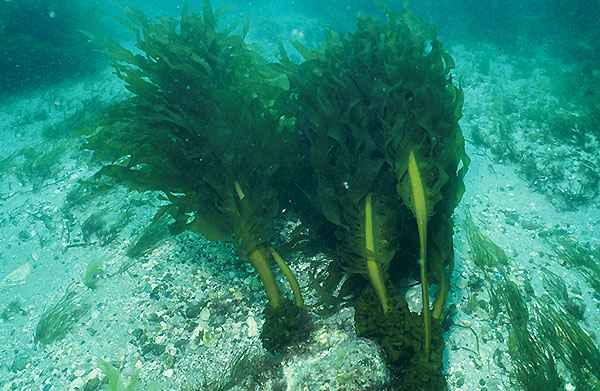
More information

To draw excess greenhouse gases, primarily carbon dioxide from the atmosphere and store it back underground. See the carbon cycle .
Level 1: Producers: plants and algae make their own food.
Level 2: Primary consumers: herbivores such as cows eat plants.
Level 3: Secondary consumers: carnivores that eat herbivores.
Level 4: Tertiary consumers: carnivores that eat other carnivores, such as big fish eating smaller carnivorous fish.
In the case of seaweed, increasing the amount of kelp (producers) in an area can lead to an increase in secondary and tertiary consumers, which release greater quantities of carbon dioxide. For more information, see this 2022 research paper for the University of Tasmania (PDF).
A trophic cascade is a side-effect when a trophic level (species such as top predators) of an ecosystem is reduced or removed. This results in a negative ‘domino’ effect because their interactions with other species would normally keep the entire ecosystems balanced. Removing or reducing the number of whales, for example, interrupts the vital exchange of nutrients that support the growth of plankton, and with them, the other species (including humans) which rely on them for their existence.
Another simple example is removing top predators. Removing wolves, for example, would cause their prey, such as deer, to multiply in number. Too many deer means the ecosystem that once supported them will be depleted because the deer over-graze their habitat, leading to problems such as soil erosion, loss of soil carbon, and a reduction in biodiversity of plants and other animals.
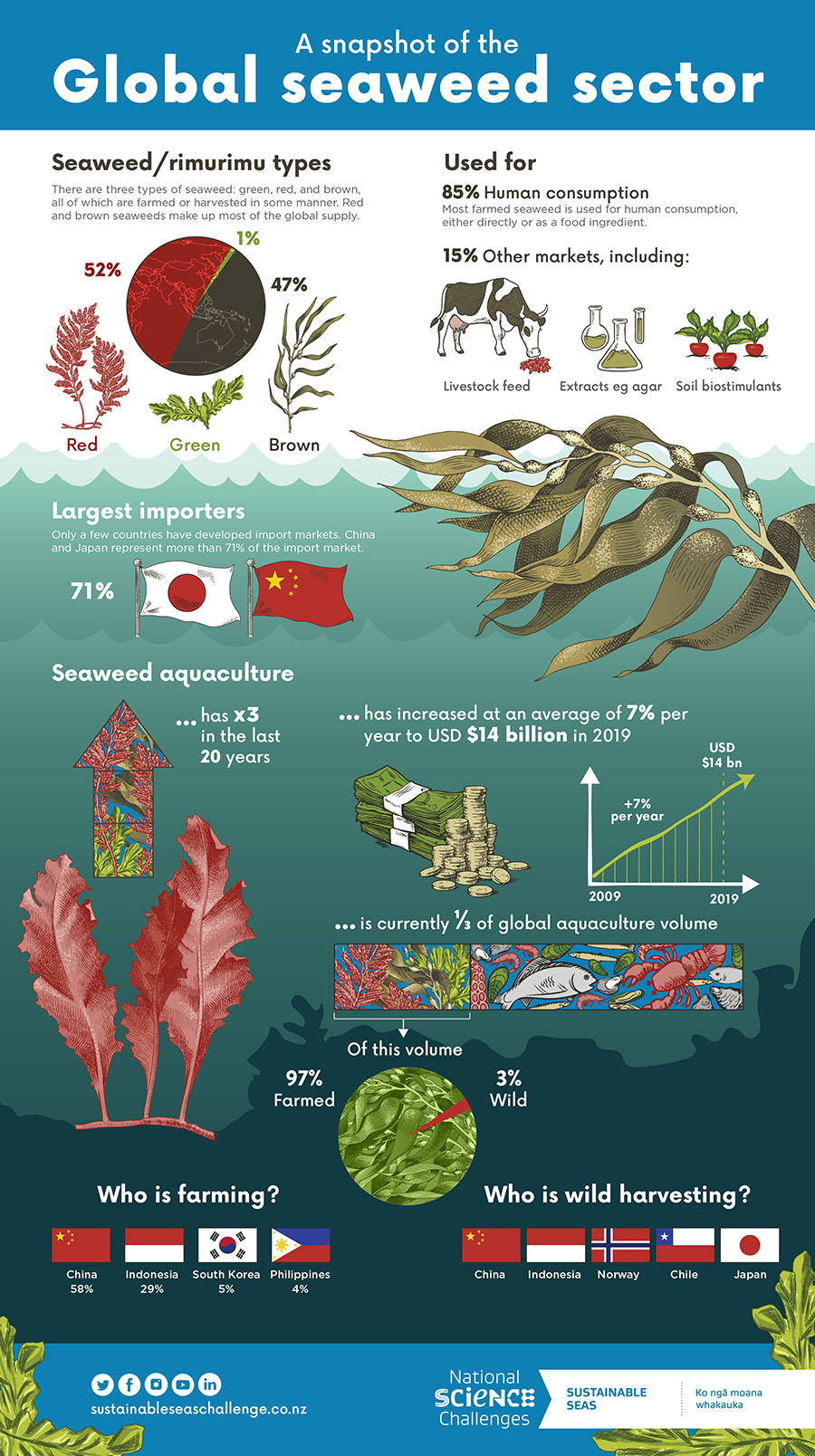
- Sustainable Seas Challenge (part of the National Science Challenge New Zealand; includes up-to-date research links and papers)
- Landcare Research
- Cawthron Institute
- Blue Carbon NZ
- Blue Kelp Akaroa
- 2024: Help for kelp: saving the Great Southern Reef : Australian Geographic article on saving giant kelp ( Macrocystis pyrifera )
- 2023: Kwiatkowski et al ; Contrasting carbon dioxide removal potential and nutrient feedbacks of simulated ocean alkalinity enhancement and macroalgae afforestation , Environmental Research Letter s 18 (October)
- 2023: Noronha; Feeding bacteria seaweed to make compostable plastic . Nature, 07 August
- 2023: Conroy; Why Earth’s giant kelp forests are worth $500 billion a year , Nature News 18 April
- 2022: Boyd et al ; Potential negative effects of ocean afforestation on offshore ecosystems , Nature Ecology & Evolution 6 pp675-683
- 2022: Glasson et al ; Benefits and risks of including the bromoform containing seaweed Asparagopsis in feed for the reduction of methane production from ruminants , Algal Research 64, May 2022, 102673.
- 2022: Gallagher et al ; Seaweed ecosystems may not mitigate CO 2, ICES Journal of Marine Science, pp1–8 (open access PDF)
- 2022: Gallagher; Kelp won’t help: why seaweed may not be a silver bullet for carbon storage after all – T he Conversation
- 2021: Bradly et al ; Stocktake and characterisation of Aotearoa New Zealand’s seaweed sector: market and regulatory focus, National Science Challenges
- 2021: Wheeler et al ; Stocktake and characterisation of New Zealand’s seaweed sector: Species characteristics and Te Tiriti o Waitangi considerations , National Science Challenges
- 2021: Clarke et al ; Stocktake and characterisation of New Zealand’s seaweed sector: Environmental effects of seaweed wild-harvest and aquaculture , National Science Challenges
- 2021: Radio NZ; R egenerating Wellington’s Seaweed Forests (also as a podcast)
- 2021: Whitelaw; Short research paper on potential of 3D ocean farming in Aoteaora
- 2021: Costa-Pierce & Chopin; The hype, fantasies and realities of aquaculture development globally and in its new geographies , World Aquaculture 52 (2) pp23-35
- Natural Climate Solutions
- Blue Carbon New Zealand
- It’s time, Canterbury – our climate change conversation
- 2020: Is Asparagopsis seaweed the answer to NZ’s methane emissions? Stuff
- 2020: New bid to farm seaweed in NZ touted as a ‘holy grail’ Stuff
- 2020: Poser et al ; The Evolution Road of Seaweed Aquaculture: Cultivation Technologies and the Industry 4.0, International Journal of Environmental Research and Public Health
- 2020: McCalley; Methane Eating Microbes , Nature Climate Change 10, pp 275–276
- 2020: Butler et al ; Multi-decadal decline in cover of giant kelp Macrocystis pyrifera at the southern limit of its Australian range , Marine Ecology Progress Series 653 pp1-18 (PDF available)
- 2019: Thomsen et al ; Local Extinction of Bull Kelp (Durvillaea spp.) Due to a Marine Heatwave , Frontiers in Marine Science 6 (Open access)
- 2019: D’Archina et al ; New Zealand Macroalgae: Distribution and Potential as National Scale – Ecological Indicators New Zealand Aquatic Environment and Biodiversity Report No. 207 , Fisheries New Zealand
- 2019: Roque; Inclusion of Asparagopsis armata in lactating dairy cows’ diet reduces enteric methane emission by over 50 percent , Journal of Cleaner Production 234, pp132-138
- 2018: Noisette and Hurd; Abiotic and biotic interactions in the diffusive boundary layer of kelp blades create a potential refuge from ocean acidification , Functional Ecology
- 2017: Sondak et al ; Carbon dioxide mitigation potential of seaweed aquaculture beds (SABs), Journal of Applied Phycology 29, pp2363–2373
- 2016: Jones; How Growing Sea Plants Can Help Slow Ocean Acidification , Yale360
- 2016: Kinley et al ; The red macroalgae Asparagopsis taxiformis is a potent natural antimethanogenic that reduces methane production during in vitro fermentation with rumen fluid , CSIRO publications (Australia)
- 2016: Krause-Jensen et al ; Substantial role of macroalgae in marine carbon sequestration , Nature Geoscience 9, pp737–742
- 2016: Machado et al ; Identification of bioactives from the red seaweed Asparagopsis taxiformis that promote antimethanogenic activity in vitro ; Journal of Applied Phycology 28, 3117–3126
Navigation for News Categories
Growth framework developed for new zealand's seaweed industry.
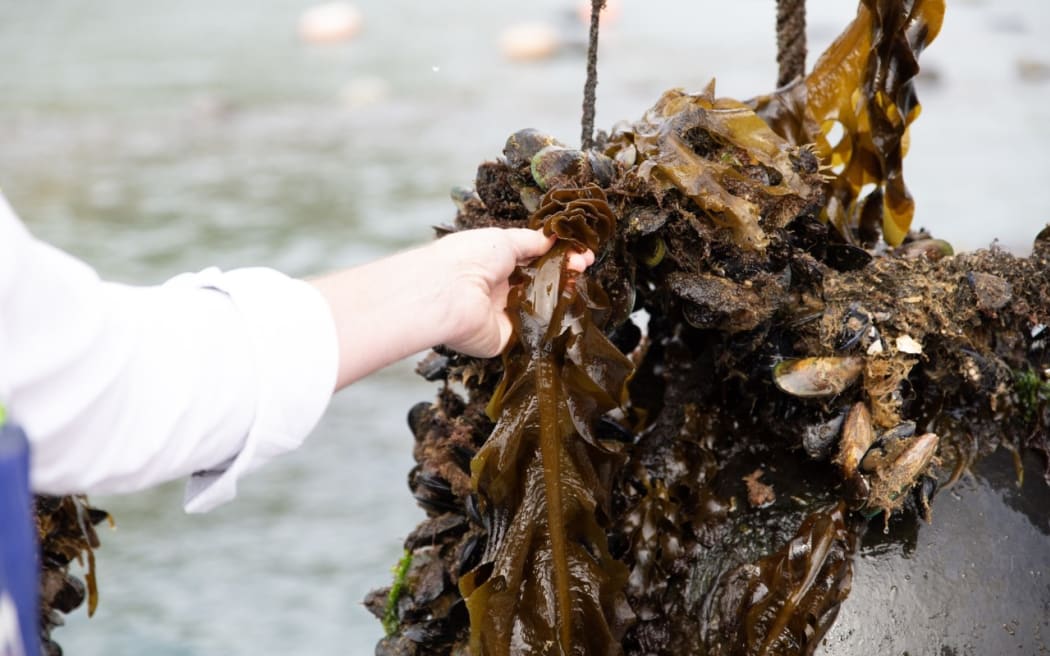
At the moment, companies are either collecting seaweed from the shore or using bycatch from mussel farms. (file photo) Photo: RNZ / Tom Furley
A roadmap has been developed for how New Zealand could grow its seaweed industry.
There is already an emerging seaweed sector in New Zealand but it is very small compared to international markets.
Sustainable Seas National Science Challenge has funded co-development of the Seaweed Sector framework to encourage a flourishing, intergenerational sector - one that does good business while upholding the mana of the moana and communities around Aotearoa.
Researchers from Cawthron Institute and EnviroStrat helped develop the framework, which outlines a vision of what the sector could look like in the future and sets out a pathway for getting there.
It highlights barriers to growth such as investment, regulation, and a lack of knowledge and suggested the industry look at research and development for creating seaweed hatcheries.
At the moment, companies are either collecting seaweed from the shore or using bycatch from mussel farms.
EnviroStrat chief executive Nigel Bradley said in 2019, the global value of seaweed aquaculture was US$14 billion (NZ$24.3b) and it had been growing by about 7 percent annually since then - so there was plenty of opportunity for growth.
"The growth potential is huge but it's important to note that we will never be able to compete with in particular asian producers because a lot of the species they grow are for their own markets," Bradley said.
"What we've had to do is take a step back and think what is the potential here and we are already seeing companies like Agrisea and Waikaitu creating products for the agriculture and horticulture sector through fertilisers and feed supplements," he said.
"As a country we have a unique opportunity to influence the sector before it has fully developed; this enables us to identify and prioritise opportunities to achieve the vision that rimurimu/seaweed contributes significantly to New Zealand's economy and supports thriving ecosystems, communities and culture."
One of project's main recommendations has already been met with the launch of a new 'sector voice', the Aotearoa New Zealand Seaweed Association (ANZSA).
ANZSA chair Clare Bradley said interest in seaweed aquaculture was growing around the world as an opportunity for positive environmental and social outcomes.
"In many cases, this interest is being backed by significant international investment. To ensure we grow a sector with enduring benefits for Aotearoa New Zealand, we need a similar level of investment in quality research and value chains that deliver healthy ecosystems and high value products.
"We must also acknowledge a te ao Māori perspective. Respecting the whakapapa, mātauranga and the relationships mana whenua and mana moana have with rimurimu (seaweed) to understand the value of this taonga for future generations."
- environment
Copyright © 2022 , Radio New Zealand
Related Stories
Native seaweed research project secures substantial funding.

A research project looking at the marine ecosystem's resilience to climate-change has secured funding for its second year.
NZ firm developing seaweed drink
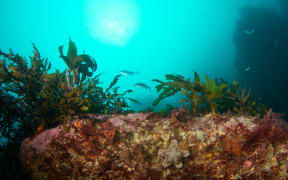
AgriSea has been turning seaweed into fertilisers and animal health products for more than 25 years. Now it is turning its attention to a seaweed drink for people.
Invasive seaweed detected on Aotea/Great Barrier Island
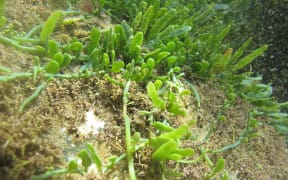
Aotea/Great Barrier Island mana whenua say biosecurity officials must eradicate an invasive seaweed species detected in the area.
Putting the brakes on belching cows
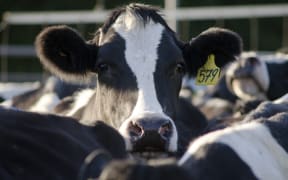
Genetic manipulation, toilet training for cows, seaweed feed, vaccines ... millions is being spent on research to reduce the methane emissions from New Zealand's agricultural industry. Audio
- Download as Ogg
- Download as MP3
- Play Ogg in browser
- Play MP3 in browser
Seaweed - an under-explored industry
The global seaweed industry is estimated to be worth more than $20 billion. New Zealand would like a slice of it.
- Which wild foods are safe to forage?
- Injuries from ram attack like being hit by a car - animal expert
- 'She's got everything you want in a cow'
- Salmon farm says tuk-tuk trial a success, ordering more
- Invasive velvetleaf discoveries at Waikato farms a 'wake-up call' for agricultural sector
Get the RNZ app
for ad-free news and current affairs

Top News stories
- Fear and anger are dominating our world right now, but are we being manipulated for profit?
- Eliza McCartney's journey back from the brink: 'It's almost like losing who you think you are'
- Hawke’s Bay serial burglar jailed for three years, two months after victim tracked her on GPS
- 'Tens of thousands' of jobs may go, warns business editor
Country RSS
Follow RNZ News
School of Biological Sciences Te Kura Mātauranga Koiora
Current research.
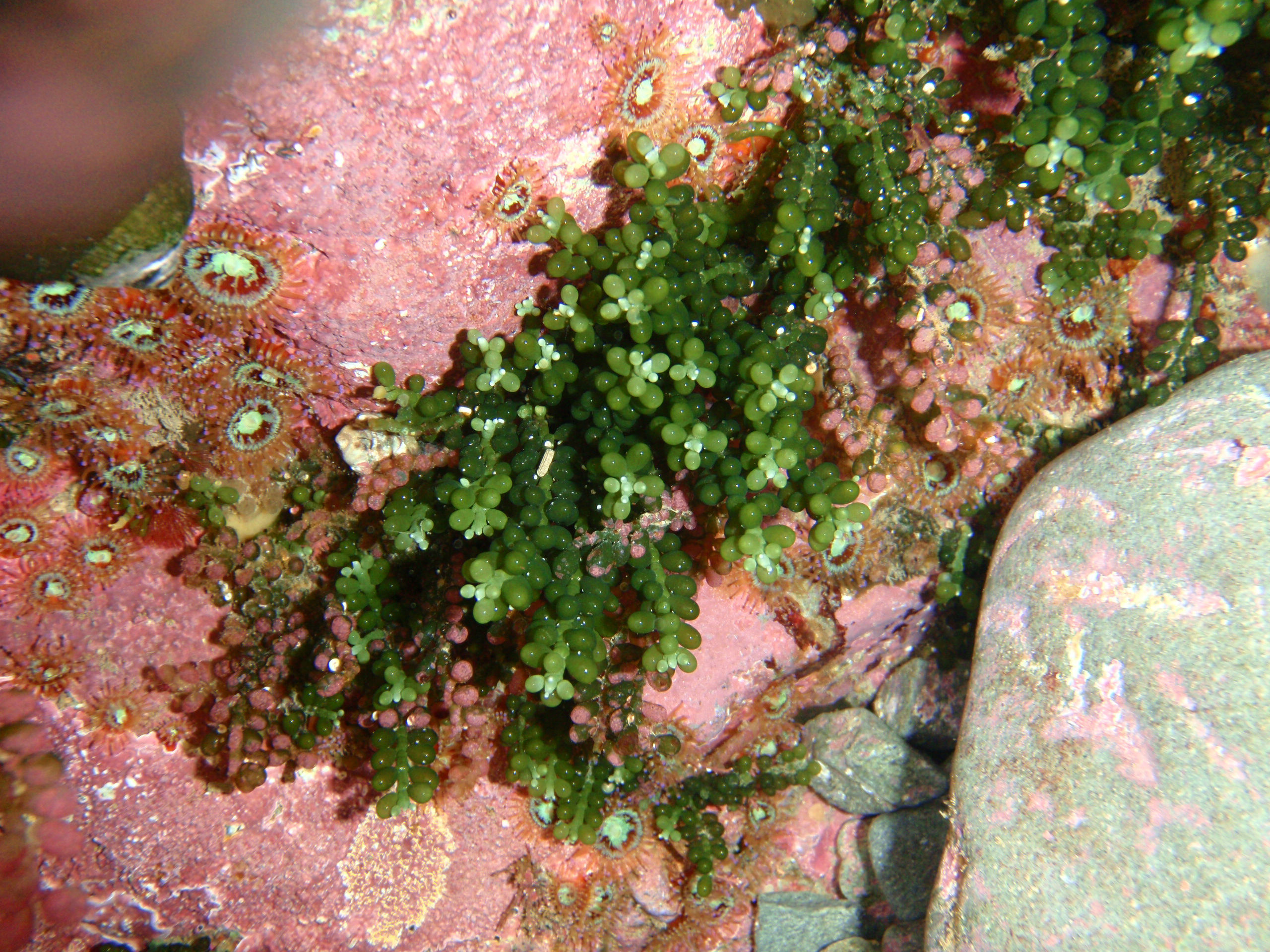
Algal diversity in New Zealand
The number of species of seaweeds in New Zealand is still not known. Neither do we fully understand how they are related to algae from other parts of the world.
Molecular data can aid this process of discovery. DNA-barcoding is a method in which DNA sequence data can illuminate species diversity that is not apparent from a plant’s morphology.
Our work on big algae like Cystophora , that should be easy to identify, has shown the value of DNA-barcoding since their taxonomy does not perfectly match their genetic variation (PhD of Joe Buchanan). We have found the alga Lessonia variegata is not a single species as previously thought, but four cryptic (morphologically identical) species, each with a unique distribution pattern (PhD of Peter Martin).
At present, a student (Maren Preuss) is studying the diversity, evolution and physiology of red algal parasites. There are a lot of these parasites in New Zealand, many that are still to be described.
Speciation in algae
Species are difficult to define and speciation processes (those that cause species to emerge) are poorly studied. My project with post-doctoral fellow Christian Boedeker and PhD student Sergio Diaz aims to see if we can show speciation in situ (sympatrically). We are studying green alga in Lake Baikal, Russia for this research, using molecular methods to determine if entities are species, and if the speciation event occurred while all the species were in Lake Baikal.
Algal phylogeography
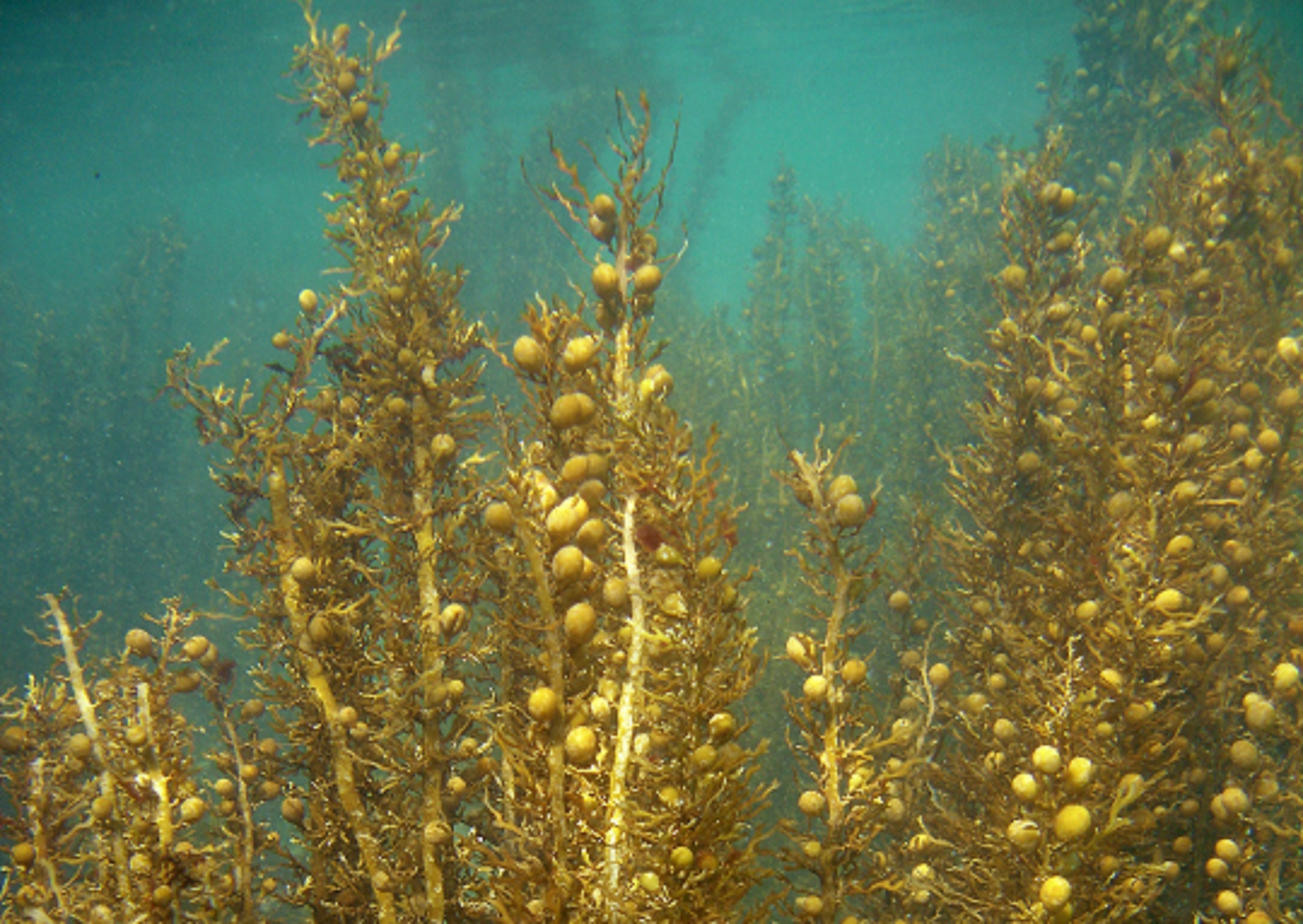
I have worked on a high intertidal red alga called Bostrychia intricata to show its distribution around the southern hemisphere and forces that may be responsible for its pattern, with PhD student Narongrit Muangmai.
Applied phycology
I have always had an interest in applied aspects of algae, especially once we know what we have (systematics, basic biology first). I have studied thermophilic algae (Galdieria), algae that grow in hot springs, and Gracilaria (the alga we get agar from) and Kappaphycus (the alga we get carrageenan from). This area of research is expanding in my laboratory, and interesting questions will be addressed in the future.
- Our Stories
- Farm Source
- Visit Fonterra
Choose your region
Please choose your location and language for the best experience.
- New Zealand NZ
- Australia AU
- Americas EN
- Sri Lanka EN
A new phase begins in Fonterra seaweed trial aiming to reduce on-farm emissions
April 29, 2022
5 MINUTE READ
- #Sustainability
- #Innovation
In 2020, we entered a partnership with Sea Forest to see if using Asparagopsis seaweed as a supplement feed for dairy cows could reduce greenhouse gas emissions. This trial now enters its next phase including a new agreement allowing Fonterra farmers first access to this potential new seaweed solution.
At Fonterra, we understand that climate change is one of the most pressing challenges of our time.
Right through our supply chain, we’re continuously looking for more efficient and environmentally friendly ways to produce and distribute our dairy foods. We believe there will be no single solution to the methane challenge, so we are investigating a number of different options.
Since then, we’ve conducted one of the only trials of feeding Asparagopsis to dairy herds in the southern hemisphere. It’s been quite the journey to get to where we are today, and we are now expanding the trial to include more farms.
Along with this new phase, is a new agreement with Sea Forest allowing all Fonterra farmers globally to get first access to the Asparagopsis solution.
This means if the trial proves successful and the product is ready to go, Fonterra farmers will be at the front of the queue.
Fonterra General Manager of Sustainability APAC Jack Holden says our grass-fed farming model makes Fonterra one of the most carbon efficient producers of dairy in the world. “However, we have an aspiration to be net zero by 2050 and are investing in R&D and partnerships to help find a solution to reducing methane emissions.”
CSIRO research has shown that Asparagopsis seaweed has the potential to reduce emissions by over 80 per cent in laboratory trials, and while Fonterra understands the reductions will vary out of the lab, all reductions count.
“As with all methane solutions we’re trialling, what we need to find out is whether we can use this supplement in a way that is safe for cows, safe for consumers and to ensure that there is no impact on milk taste or quality,” says Jack Holden.
Our access to leading dairy farmers also gives Fonterra a unique opportunity to test possible solutions and get them to scale much faster.
We have an aspiration to be net zero by 2050 and are investing in R&D and partnerships to help find a solution to reducing methane emissions.
Jack Holden, Sustainability APAC, General Manager, Fonterra
The Asparagopsis seaweed trial has taken place on Richard Gardner’s Annandale farm in the Midlands of Tasmania. It was chosen not only because Tasmania has a suitable climate, but Richard has a well-established flexible feeding and milking system.
Richard has long been into sustainability on farm, and when the opportunity came up to be involved in the trial, he jumped at the opportunity.
“Asparagopsis seaweed looks like it could be the first viable option we have had to achieve major emission reductions, and although it’s early days, it could potentially be part of the future sustainability of our industry,” says Richard
On Richard’s farm, 900 of his dairy cows have been fed small amounts of the seaweed supplement.
During the trial, we extensively tested milk for seaweed residues, and there haven’t been any red flags at any stage that have caused us to suspend the trial. We have also focussed heavily on animal health concerns and again what we see is promising at each stage.
We also compared milk production with cows who were not fed the seaweed supplement, and we found that production is unchanged.
Another focus of the trial has been working out how practical it is to use this supplement as part of normal operations, which Jack Holden says is “critical because it needs to be easy to implement and beneficial for farmers if we want it to be widely adopted.”
Based on these outcomes, we're now ready to take the trial to the next stage, where we will expand it to include multiple farms, and our commercial partner Sea Forest is ready and is set to lift its production.
Sea Forest is one of a few licenced producers of Asparagopsis for cattle feed. The licences are issued by Future Feed which is the commercial joint venture that owns the intellectual property.
Sea Forest CEO and Founder Sam Elsom says last year the company bought an additional 30ha farm as it dramatically increases its production of the seaweed supplement.
“Asparagopsis is a common seaweed native to the waters of Tasmania and New Zealand, and we’re the first in the world to cultivate it at a commercial scale through both marine and land-based aquaculture.
“We needed a food industry partner to help us take this to a commercial scale, and we partnered with Fonterra because of its commitment to sustainability and innovation.
“We're looking forward to working with Fonterra on the next phase, and although we’re still in trial phases, we believe this has potential,” says Sam.
Our Asparagopsis seaweed trial in Australia is part of our Co-operative’s wider efforts to tackle emissions and our aspiration to be Net Zero carbon by 2050.
The Co-operative is currently carrying out a number of other trials in this area including:
Tapping into its large collection of dairy cultures to create new fermentations we’re calling Kowbucha™, which could inhibit the methanogens that create methane in cows.
Working with Royal DSM, a global science-based company, to test whether DSM’s feed additive product Bovaer®, which reduces methane emissions from cows by over 30% in non-pasture-based farming systems, can do the same in New Zealand’s pasture-based farming systems.
With MPI and DairyNZ, expanding a promising trial with Nestlé to include plantain in a cow’s diet to reduce the amount of nitrogen produced, reducing carbon emissions and improving freshwater quality.
Building a Brighter Future in STEM: Fonterra and Pūhoro Partner to Empower Māori Rangatahi
11 April 2024
- Sustainability
Introducing: Fonterra’s new Sustainability Advisory Panel Members
13 March 2024
Cheese from trees: Fonterra Stirling site running on wood biomass
06 March 2024
- International edition
- Australia edition
- Europe edition

From red seaweed to climate-smart cows: New Zealand leads the fight against methane
The nation’s scientists are racing to find ways to reduce the release of methane from cows and sheep, which accounts for one third of all emissions
It is not exactly glamorous work. Measuring sheep farts is smelly, time consuming and expensive.
But for Dr Suzanne Rowe, a scientist who is breeding strains of sheep that emit less methane than regular flocks, there is nothing more important she feels she could be doing.
“New Zealand has really become a global leader in this space and there’s a lot of buzz around at the moment – it’s hugely exciting,” she says.
The release of methane gas from New Zealand sheep and cattle accounts for one third of the country’s greenhouse gas emissions, the single largest contributor in the country.
Since 1990, methane gas from stock has increased by 10%, according to the ministry of the environment, along with a 70% increase in dairy cattle and a 44% drop in sheep numbers.
Accordingly, methane has found itself in the crosshairs of the government’s climate action policy, and scientists around the country are being given the green light to run free with their best and brightest ideas to lower emissions.

Agriculture ‘must be part of the solution’
In November, the prime minister, Jacinda Ardern, pushed the Zero Carbon Act through parliament with cross-party support, saying the world was “undeniably warming” and all greenhouse gases must be reduced to net zero by 2050 in order to honour agreements made under the Paris climate accords.
“We have to start moving beyond targets,” Ardern said. “We have to start moving beyond aspiration. We have to start moving beyond hope and deliver signs of action.”
Under the zero carbon legislation, the methane targets are separated out from other greenhouse gases, with the goal of reducing biogenic methane by 10% by 2030, and 24-47% by 2050.
“Agriculture is incredibly important to New Zealand,” she said. “But it also needs to be part of the solution. That is why we have listened to the science and also heard the industry and created a specific target for biogenic methane.”
In Nelson, at the top of the South Island, the Cawthron Institute has recently been awarded government funding to cultivate and research a red native seaweed known as Asparagopsis armata.
The agriculture minister, Damien O’Connor, has said if this seaweed is able to be mass produced, it could be a “game-changer for farmers here and around the world” as it has been proven to reduce stock methane emissions by as much as 80% when added as a feed supplement at quantities as low as 2%.
“The holy grail is going to be getting enough of the stuff,” Cawthron chief executive Prof Charles Eason told the Guardian. “It’s got a complicated life cycle. One of the barriers to getting this to market is growing enough of the stuff in ways that are cost effective to make it commercially viable.”
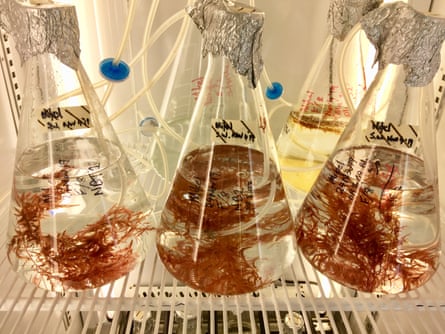
O’Connor said the potential of the seaweed not only in New Zealand but around the globe was “huge”.
“Other products typically provide reductions of between 10% and 20%,” he said. “Australian research estimates that if just 10% of global ruminant producers adopted Asparagopsis as an additive to feed their livestock, it would have the same impact for our climate as removing 50 million cars from the world’s roads.”
Building cattle for a climate-altered future
Several hundred kilometres north in the Waikato city of Hamilton – the heart of dairy country – Dr Bjorn Oback from AgResearch has been given NZ$10m in government funding to design a “climate-smart cow”.
There are more cows than people in New Zealand and while they have become a mainstay of the economy they also draw the ire of environmentalists for their high emissions profile, intensive impact on the land and muddying and polluting waterwarys.
Oback says specialised breeding programmes can “take decades” to reach their desired outcome, but using genetic modification his team can design a climate-smart cow much more quickly and precisely – though the process remains controversial.
As well as working towards manipulating the genes that control methane admissions , Oback is also focused on designing cattle that will thrive in a climate-altered future – animals that are more heat tolerant, hardy and productive.
The five-year programme is only three months in, but is already targeting coat colour adapation – creating cows that are lighter in colour, making them more heat-tolerant.
An important feature of the programme was using “elite” cattle, Oback said, so not only would they emit less methane and be climate adaptive – they’d also be super performers.
“We’re taking a high-performing elite dairy background, and then we’re putting mutations on top of it.”
Oback’s work is intertwined with Rowe’s research into low emitting sheep in the south of the country. For Oback to study – and try to manipulate – the genes of low-emitting stock, he is invested in the survival of Rowe’s flocks, who are now in their third generation.
Rowe and her team’s work is creating a buzz in the agricultural community, because not only do her sheep have low methane emissions, they also produce more wool and are shown to be hardier and healthier than normal sheep. At this point no-one knowns why, but 20 major breeders have already signed on to produce flocks, and the low-emission sheep have the backing of industry body Beef and Lamb New Zealand.

“We have demonstrated a 10% difference in methane produced between the average sheep in both the high and low methane breeding lines,” says Rowe.
“It is a very natural system, it’s been used for eons. Domestication and breeding animals is something everybody is familiar with and it’s cumulative. If you breed an animal tomorrow the affect is always there and the offspring that come after them always have that effect.”
Many of the methane reduction programmes in New Zealand are in their nascency, with climate smart cows at least five years away and the mass roll-out of Asparagopsis armata at least five to ten.
But agricultural scientists and farmers say after decades of indecision and uncertainty concrete action is finally underway in New Zealand – and it is drawing global attention.
Myles Allen is a climate change scientist at Oxford University and head of its Climate Dynamics group. He recently visited New Zealand and said he was impressed with how engaged industry leaders, government and the farming community were.
“I only wish New Zealand could convince others … to take such a sensible approach.” he said.
- New Zealand
- Climate crisis
- Asia Pacific
- Climate science
- Agriculture
Most viewed
CH4 Global partners with Food Entrepreneurship and Manufacturing Institute to combat methane emissions in the cattle industry
- Story by Devyn Raver
- Photos by Tom Campbell
- April 17, 2024
T he Food Entrepreneurship and Manufacturing Institute (FEMI) , housed within Purdue University’s Department of Food Science , offers a guiding light for entrepreneurs and businesses navigating the intricate path from food or beverage product conception to market readiness. Established nearly two years ago, FEMI cultivates partnerships with forward-thinking companies dedicated to meeting demands within the food and agriculture industry.
With a team comprised of staff, graduate and undergraduate students and collaborating faculty members, FEMI delivers tailored support to address the needs of their partners. Allie Kingery, Managing Director of FEMI, describes the institute as a “hub,” capable of handling diverse challenges internally or by tapping into the rich resources available across Purdue University.
One of FEMI’s earliest collaborators, CH4 Global , is a pioneer in reducing methane emissions from ruminant animals, particularly cattle. The significant environmental impact of livestock farming stems largely from the methane emissions generated during these animals' digestive process. Through innovative advancements, CH4 Global specializes in developing sustainable feed additives made from natural seaweed material, helping mitigate climate impacts within the global agricultural sector.
Most people in the U.S. aren’t aware that on a global scale, agriculture has a bigger impact than oil and gas on the climate. There’s now this call to action – there are actual solutions that the U.S. can lean into to help themselves and the planet.” -Rowena Pullan, Chief Brand Guardian for CH4 Global

With CH4 Global primarily operating from lab spaces in Australia and New Zealand, Paul Russo, Vice President of Product Development for CH4 Global, sought a strategic partner with strong expertise in education and research closer to his Cincinnati, Ohio home base.
“CH4 Global had a lot of hope that within Purdue’s College of Agriculture they would get traction and wanted to lean on FEMI for strengthening their U.S. presence, all in the name of helping come up with solutions to mitigate methane emissions in cattle,” explained Kingery. “We found that their requests lined up perfectly with what we can do.”
Aligned with CH4 Global’s commitment to sustainable agriculture, FEMI supported a series of testing agreements for seaweed-based feed solutions. These collaborations will gather comprehensive data on microbial properties, nutritional content, shelf-life, particle size and bulk density, essential for integrating seaweed into farming practices and creating a product easily consumed by cattle.
Russo acknowledges FEMI’s pivotal role in characterizing both the raw material, Asparagopsis, and finished product, and explains that, “It’s one thing to have capabilities, but it’s another to establish a partnership that brings those capabilities to life in terms of innovation and product development.”
FEMI’s work extends beyond technical expertise; they’ve also assisted in conducting our first stability study. Now we can demonstrate that we not only have a good design, but we also have a stable product that would last as long as we need it to in the market." -Paul Russo

The project with CH4 Global has been our most significant in terms of both funding and developing a long-term partnership, and also really shows the depth of what food scientists are able to support." -Allie Kingery
Echoing this sentiment, Russo expresses his appreciation for working with Kingery and Dharmendra Mishra, associate professor of food science, as well as the students. “FEMI has the capabilities and the right educational staff, but the bonus has been seeing students eager to jump on board and participate in making a meaningful impact on the climate.”
students work on products from start to finish

As the seaweed-based feed project progresses into its next testing phase, both FEMI and CH4 Global are excited to explore potential product possibilities and new avenues for expanding their partnership.
Featured Stories

The Boilermaker Butcher Block’s selections will now include farm fresh eggs laid by Purdue...
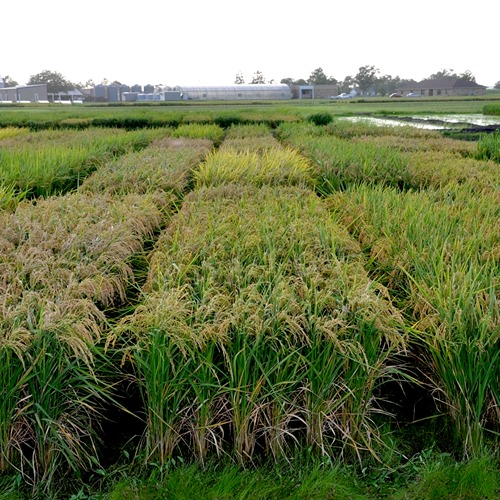
Climate change, extreme weather events, unprecedented records in temperatures and higher, acidic...
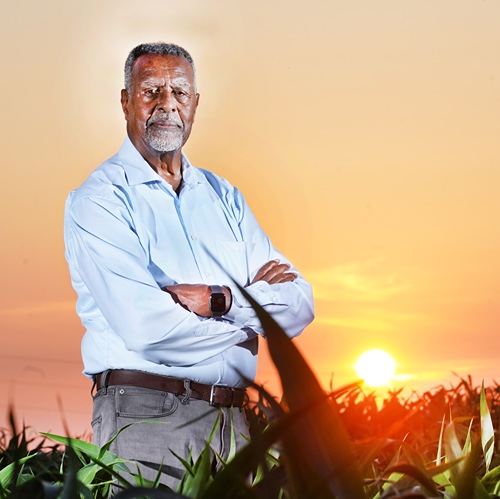
Last October, 2009 World Food Prize Winner Gebisa Ejeta received the highest scientific honor...

Learning the science behind farming helped Haley adapt to a new role in her family-owned...
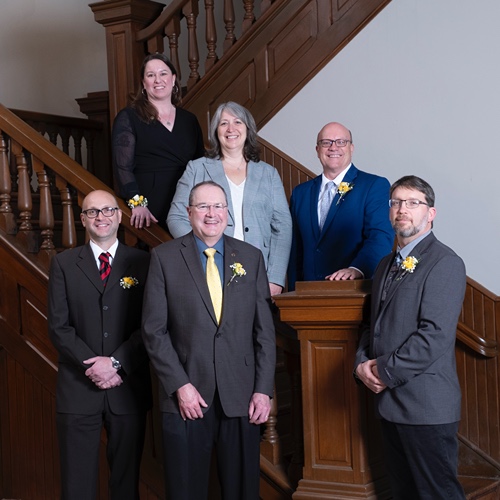
The College of Agriculture recognized six alumni at the Distinguished Agricultural Alumni award...
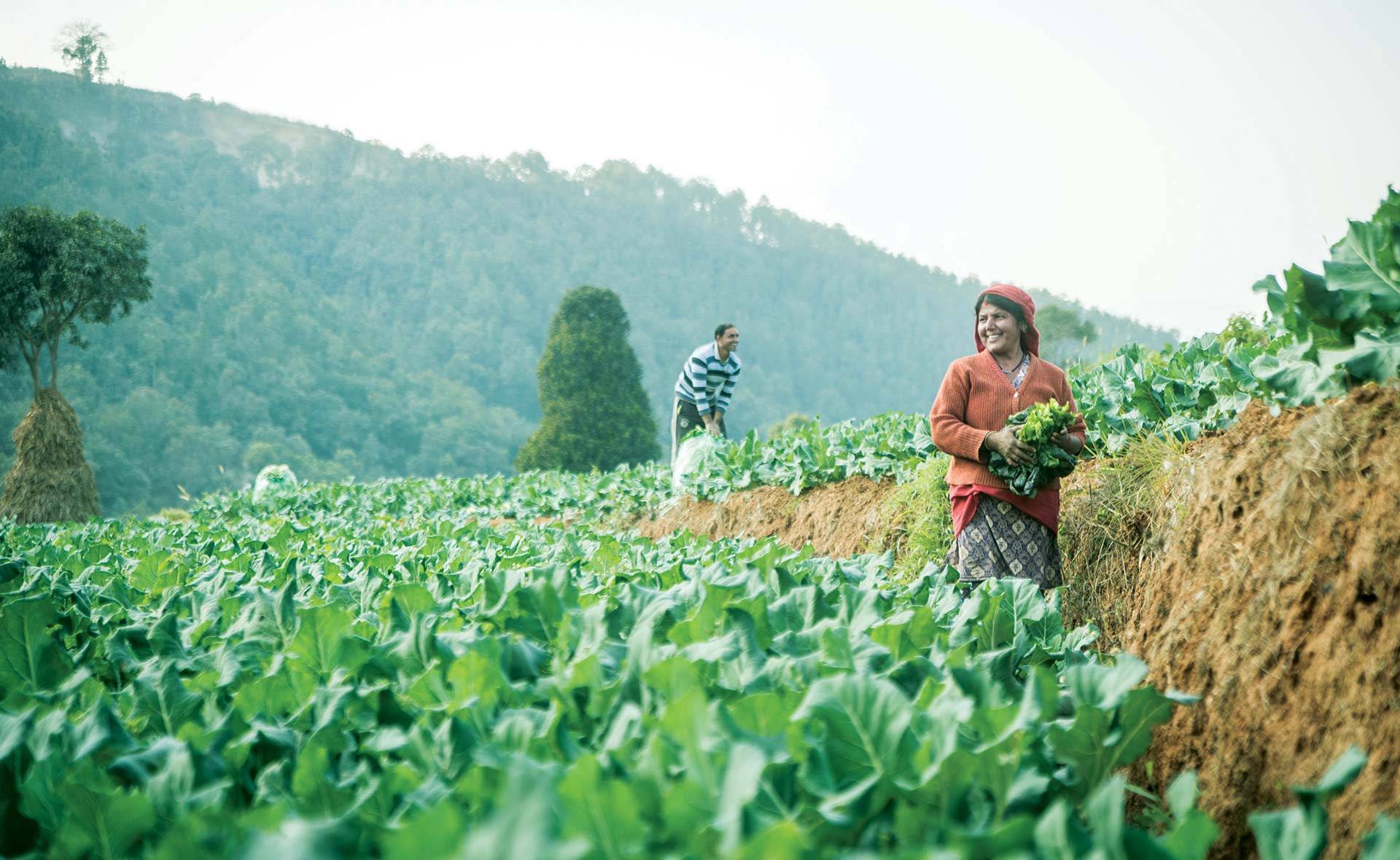
Alexis Ellicott's future in international agriculture became crystal clear upon meeting...

IMAGES
VIDEO
COMMENTS
In addition, NIWA has more than 30 years of experience researching seaweed genetics, including marker amplification, sequencing, phylogenetic analysis for sample identification, molecular systematics and species recognition. We also have expertise in qPCR and droplet digital PCR (ddPCR), DNA extraction and amplification preparation for ...
Seaweed is a huge multi-billion dollar industry in Asia, but the potential of seaweed is yet to be fully explored and maximised in New Zealand. Dr Magnusson says seaweed represents a largely untapped resource for materials and bioproducts that will enable sustainable diversification of New Zealand's aquaculture industry.
Seaweed research produces results. Joint media release. 14 December 2020. Research on seaweed species found in abundance around New Zealand has led to the development and licencing of a promising new product. The three-year research programme led by Scion set out to test the properties of different seaweeds, including Undaria pinnatifida and ...
Seaweed has huge potential to contribute to Aotearoa New Zealand's blue economy. In 2018, the global seaweed sector was valued at more than $13 billion USD, and grew 8% from 2016 to 2018 (fao.org). Global seaweed production has more than doubled in the last 20 years, exceeding natural supply - now more than 30% of global aquaculture ...
Seaweed aquaculture is an emerging sector in New Zealand. The bulk of global production of cultivated seaweed comes from East and South East Asia regions - dominated by long-established production in China, Indonesia, South Korea, and the Philippines. There is a history in New Zealand of harvesting and making use of beach-cast and wild ...
The ecological effects of climate change on New Zealand seaweed communities are poorly known in New Zealand, due to the breadth of ecosystems that exist and the large number of seaweed species that live throughout New Zealand. This is despite intensive research on some species and select stressors. In this review, we summarise the measured ...
"There's limited research and development available for ocean-grown seaweed in Aotearoa currently, which is a significant barrier to establishing a seaweed sector," says Mawae Morton, Executive Chair of GreenWave NZ. "This project will provide the proof-of-concept for farming New Zealand seaweed at a commercial scale.
The commercial landscape of seaweed use in New Zealand (NZ) has shifted and evolved since it was last reviewed in 2006. ... Hui_April10_Seaweed_research.pdf (Accessed 1 December. 2019). Anonymous ...
Inputs to this research report included reviews of sector reports and scientific papers, along with interviews of individuals involved in seaweed research, businesses, regulation and development projects. For New Zealand to have a sustainable and high value seaweed sector, the market review report suggested:
The commercial landscape of seaweed use in New Zealand (NZ) has shifted and evolved since it was last reviewed in 2006. One of the largest changes saw the introduction of Macrocystis pyrifera and green-lipped mussel spat (which is landed attached to beach-cast seaweed) into the Quota Management System—the primary tool for commercial fisheries management in NZ.
The impacts of global climate change are threatening the health and integrity of New Zealand's seaweed ecosystems that provide crucial ecological, economic, and cultural benefits. Important species that comprise these ecosystems include canopy forming large brown algae (fucoids and kelp), and understorey species.
Seaweed production has tripled over the last 20 years with a growth rate of 7% per year on average over the last decade. Global value of seaweed aquaculture in 2019 was approximately US$14 billion", explains Project Leader Serean Adams, Aquaculture Group Manager at Cawthron Institute. "Right now, New Zealand's seaweed sector is in its ...
"We believe our seaweed research, alongside our other aquaculture research, could significantly contribute to achieving the government's target of aquaculture becoming a $3bn industry by 2035. Last year alone New Zealand's aquaculture sector generated over $600m in revenue, employing over 3000 kiwis, and we believe our science will help ...
AgriSea also has a research collaboration with New Zealand's National Science Challenge funding allocated to the Revitalise te Taiao land-use sustainability program, which has seen a local Paeroa-based project, led by AgriSea, allocated $2.7 million to test farming methods that aim to enhance the health and strength of the soil across 10 farms.
the existing Aotearoa New Zealand seaweed sector and describes the current markets and regulatory environment, and also to Wheeler et al. ( 2021), which provides an overview of seaweed
Seaweed is a diverse group of marine macro-algae and plants that, like all plants, uses photosynthesis and carbon dioxide to grow. While it's well understood that kelp stores far more carbon than trees, and it does so faster, the exact amount hasn't been quantified. In New Zealand, one of Blue Carbon Services Ltd research projects in ...
At the moment, companies are either collecting seaweed from the shore or using bycatch from mussel farms. EnviroStrat chief executive Nigel Bradley said in 2019, the global value of seaweed aquaculture was US$14 billion (NZ$24.3b) and it had been growing by about 7 percent annually since then - so there was plenty of opportunity for growth ...
PDF | On Sep 6, 2023, Christopher E Cornwall and others published Predicting the impacts of climate change on New Zealand's seaweed-based ecosystems | Find, read and cite all the research you need ...
With leading seaweed scientists Dr. Marie Magnusson and Dr. Rebecca Lawton at the University of Waikato and Premium Seas Limited, a group of seaweed farmers and entrepreneurs committed to developing the seaweed farming sector within New Zealand, EnviroStrat will build kelp hatcheries and test farm designs in the Hauraki Gulf and Bay of Plenty ...
Current Research. Algal diversity in New Zealand. The number of species of seaweeds in New Zealand is still not known. Neither do we fully understand how they are related to algae from other parts of the world. Molecular data can aid this process of discovery. DNA-barcoding is a method in which DNA sequence data can illuminate species diversity ...
CSIRO research has shown that Asparagopsis seaweed has the potential to reduce emissions by over 80 per cent in laboratory trials, and while Fonterra understands the reductions will vary out of the lab, all reductions count. "As with all methane solutions we're trialling, what we need to find out is whether we can use this supplement in a ...
In New Zealand, edible seaweeds are sold at small, family-run market stalls selling fresh, foliose seaweed Ulva (sea lettuce) and by larger commercial operators selling a range of dried seaweeds. Among these are Ulva and various species of the red seaweed Porphyra (known in New Zealand by the Māori name of karengo) and a number of brown ...
In Nelson, at the top of the South Island, the Cawthron Institute has recently been awarded government funding to cultivate and research a red native seaweed known as Asparagopsis armata.. The ...
This review delves into the burgeoning field of seaweed proteins as promising alternative sources of protein. With global demand escalating and concerns over traditional protein sources' sustainability and ethics, seaweed emerges as a viable solution, offering a high protein content and minimal environmental impacts. Exploring the nutritional composition, extraction methods, functional ...
With CH4 Global primarily operating from lab spaces in Australia and New Zealand, Paul Russo, Vice President of Product Development for CH4 Global, sought a strategic partner with strong expertise in education and research closer to his Cincinnati, Ohio home base.
Brazil's Pará state has now protected almost all of its Amazonian coastline after establishing two new conservation units that make up the world's largest and most conserved belt of mangroves ...